

How Big Are Yachts? 5 Types Explained (With Numbers)
Yachts can come in a variety of sizes and weights. Before you purchase a yacht, you must know what size yacht you need.
The size and weight of the yacht that you need will depend greatly on what your intended use is for the yacht that you are purchasing.
Table of Contents
Here’s everything you need to know about the weight of yachts:
Here’s an Idea of How Big Yachts Are:
The term “Yachts” refers to a pleasure vessel that is at least 30 feet in length and has some type of cabin with some amenities. The biggest luxury yacht is 590 feet (180 meters) and 13,136 gross tons.

What Do We Mean When We Talk About Weight?
There are two types of weight for a boat, dry weight, and wet weight.
Dry weight is the weight of the boat without any fluids in the tanks. Wet weight is the weight of the boat with the fluids in the tanks.
You can also have a loaded weight, which is the wet weight, including any additional toys or equipment you have stored onboard.
What Do We Mean When We Talk About Length?
There are many different ways to calculate a boat’s length. For this reason, you want to make sure that you have a clear idea of what the length of your boat really is.
The boat’s registered length is generally the maximum overall length, which is the length on deck plus any bowsprit or swim deck. The length of the boat on the waterline is also an important boat characteristic that you should know.
Due to the shape and construction of the hull, these numbers may differ.
For example, if you have a boat that has a 50-foot deck with no bowsprit, your registered length will be 50 feet.
Some boats are measured using “LOA,” otherwise known as length overall.
Why Is Knowing The Weight And Length Important?
The most important reason to know your boat’s weight and length is for when you choose to shop for trailers or even to determine if your vehicle can haul it.
If you try to tow a boat without an accurate representation of the weight or length, you can ruin your vehicle’s engine and even your towing equipment, not to mention have serious safety issues.
Another reason to know about your vessel’s weight is to know how much you can bring for your trip without packing more than the maximum weight allowed.
It is also important to know your weight and how it can affect your boat, especially when it comes to speed.
Different Types of Boats and Their Average Weight and Length
Below are some different types of boats and their average size and weight, and the factors that go into them.
1. Luxury Yacht

Yachts are normally classified as any watercraft that can be used for pleasure or sport and can range from 30 ft to over 100 ft.
While a yacht can be as small as 30 ft. long, a yacht is often considered a cabin cruiser until it is 39 ft. or more, then it is considered a proper yacht.
A yacht would be considered a large yacht once it’s length is over 79 feet. A yacht is considered a superyacht or megayacht if it is over 115 feet long.
The yacht the holds the record for being the longest yacht is 590 feet long. This yacht is called the “Azzam” and has held onto its title for over 5 years.
Because of the wide variety of sizes, the weight can vary greatly when it comes to yachts, and it is hard to nail down an average.
Some more distinctive differences between yachts include:
- These yachts are single-deck yachts with one living quarter below . They are often sleek and sporty.
- Also known as a sedan bridge or sport bridge yacht. This yacht has an area on top of the superstructure that features a view all the way around the vessel.
- This deck up top can offer a control station or even lounge seating, depending on its size.
- Also known as a pilothouse motor yacht, cockpit motor yacht, or sky lounge. This term can be used for any large recreational vessel that is motor powered.
- Usually, this means a multi-deck vessel similar to a flybridge but instead has a large interior deck.
- Often classified as a mega yacht, which is normally any vessel 80 ft. or more. This vessel is exactly what it sounds like.
- It is a yacht with three levels of enclosed living space.
- A sportfishing yacht is any yacht that is geared towards fishing.
- They often have areas designated to storage for rods, bait, tackle, and even areas to store the day’s catch.
2. Sailboats

Large sailboats are yachts propelled by sails and can be found in lakes, rivers, and even out on the ocean. Today, they almost all have auxiliary power in the form of an engine.
While the weight and length of a sailboat can drastically vary, the average weight of a sailboat is about 8,800 pounds. This weight does not include added gear, equipment, or fluids.
The weight will vary greatly depending on the length of the sailboat. Sailboat lengths can range between 8 feet to 472 feet.
The 472-foot sailboat also carries three masts that tower at over 91 feet each. This can definitely add more weight than the 8-foot vessel.
Listed below are 6 examples of sailboats and their weights and lengths:
- Catalina 16 LOA: 16 ft. 4 in. Hull Weight: 430 pounds
- Hunter 22 LOA: 21 ft. 4 in. Hull Weight: 3,200 pounds
- C&C 27 LOA: 27 ft. 4 in. Hull Weight: 5,180 pounds
- Erickson 28.5 LOA: 28 ft. 7 in. Hull Weight: 8,500 pounds
- Pearson 39 LOA: 39 ft. 3 in. Hull Weight: 17,000 pounds
- Swan 48 LOA: 47 ft. 11 in. Hull Weight: 36,000 pounds
3. Speed Boats (Cigarette Boats)

Speed boats are sleek and built for achieving high levels of speed.
These boats are not made for watersports and should not be confused with ski boats.
A speed boat’s average weight is slightly less than that of a sailboat at roughly 8,000 pounds.
Some of the factors that determine a speed boat’s weight can include their length, engines, and sleekness.
Listed below are some examples of speedboats and their weights and lengths:
- Cigarette 38 Top Gun LOA: 37 ft. 8 in. Hull Weight: 9,175 pounds
- 32 Thunder Cat LOA: 32 ft. Hull Weight: 5,400 pounds
- M35 LOA: 35 ft. 4 in. Hull Weight: 9,250 pounds
4. Deck Boats or Pontoon Boats

Deck boats and pontoon boats both have large decks and are mostly intended for recreational use.
Pontoon boats have the lowest average weight at 3,100 pounds .
Because they do not have large hulls, they can be lighter and cut across the water easier than boats with larger hulls.
Listed below are some examples of deck boats and their weights and lengths:
- NauticStar 211 Angler (Deckboat) LOA: 20 ft. 9 in. Weight: 2,100 pounds
- Stingray 212SC (Deckboat) LOA: 21 ft. 11 in. Weight: 3,100 pounds
- Hurricane SunDeck 2690 LOA: 26 ft. 4 in. Weight: 4,475 pounds
5. Cabin Cruisers

Cabin cruisers are large boats that are sometimes looked at as mini-yachts.
These boats allow for sleeping accommodations and other luxuries afforded in their cabin space.
Like the sailboat, a cabin cruiser’s weight can vary. However, they do tend to have a smaller range than sailboats.
The average weight of a cabin cruiser is about 8,700 pounds.
One of the major factors in the weight of cabin cruisers is the size of the sleeping accommodations below. Some models of cabin cruisers can even sleep up to 10 people.
Listed below are some examples of cabin cruisers and their weights and lengths:
- Larson 274 Cabrio LOA: 28 ft. Dry Weight: 6,001 pounds
- Rinker 301 Express Cruiser LOA: 32 ft. Dry Weight 7,640 pounds
- Bayliner 285 SB LOA: 28 ft. 9 in. Dry Weight: 8,056 pounds
Picking a Yacht:
Yachts can vary in a wide array of sizes, weights, styles, and even purposes.
You can race them, fish on them, and cruise around at an easy pace.
You can take a day trip or even take personal cruises that last days or weeks.
With ample deck and cabin space that offers activities, sunbathing, kitchens, lounges, and sleeping quarters, a yacht is often the most comfortable way to experience the open water.
To choose a yacht, you will want to know what type of yacht you are looking for and what you want to use it for.
You also want to make sure when picking a yacht; you make sure you keep the weight and length in mind to make sure you have a proper towing vehicle and trailer for your vessel.
Click to share...
A Complete Guide to Yacht Types and Sizes
- by yachtman
- August 28, 2023 August 26, 2023

Yachts, symbols of luxury and leisure, provide a stunning escape. From motor yachts to sailing yachts, the world of yachting is both diverse and captivating. Journey with us as we explore the different types and sizes of yachts, uncovering their secrets.
Climb onboard a superyacht , the queen of the seas. These floating palaces boast remarkable dimensions, with amenities such as swimming pools, helipads, and even submarines. Ideal for those seeking indulgence, superyachts are the epitome of yachting excellence.
For a more intimate experience, try a luxury motor yacht . With powerful engines, they let you visit multiple destinations quickly. Enjoy the lap of luxury as you cruise across the sea, appreciating every moment on board these vessels.
Sailing lovers will appreciate classic sailing yachts . Watch their silhouettes gracefully cut through the waves, powered by wind. Feel the passion for sailing, and the freedom, on an adventure akin to ancient seafarers. Uncover your inner explorer while savoring unparalleled serenity.
Catamarans are ideal for sailing with precision and finesse. With twin hulls offering stability and space, catamarans offer great comfort. Enjoy vibrant sunsets to tranquil anchorages, and bliss on water, with these versatile vessels.
For those keen on exploration, expedition yachts are perfect. Built tough and with advanced tech, they are designed for explorations to remote areas. Discover untouched landscapes, encounter wildlife, and make memories in the far-flung corners of the world.
Types of Yachts
Sailboats to mega-yachts – there’s a large choice of yachts. Let’s delve into the types and sizes that meet different needs.
Take a gander at the table below for an overview of yachts:
Sailing yachts are graceful and use wind power. Motor yachts are speedy and powered by engines.
Catamarans stand out with their steadiness and roominess – great for a leisurely cruise. Trawler yachts are great for long-distance trips because they’re fuel-efficient and have comfy living areas.
Adventurous souls should check out expedition yachts . Flybridge yachts have an extra deck level for entertainment and relaxation.
Sports fisher yachts are designed for fishing, with special gear and amenities.
Don’t miss out on your dream yacht – find the perfect one and go on amazing sea experiences. Start your journey now!
Sizes of Yachts
Yachts come in plenty of sizes, each with its own unique features and capabilities. To discover the perfect yacht for your needs, let us explore the sizes of yachts via a table showcasing their specifications.
Here’s what the table looks like:
Moreover, take into account that certain yachts have stability systems, others prioritize speed, and some are customized. I once met a yacht owner who wanted a retractable roof! With the help of creative builders, his dream was fulfilled and he got to enjoy a unique experience on the open seas.
Factors to Consider in Choosing the Right Yacht
Making the right yacht choice involves many key points to think about. These include size, type, budget, use and preferences, like amenities . To decide wisely, assess each factor and see how important they are. Here’s a table of the main considerations when choosing a yacht:
In addition, there are unique details you should consider, like if you plan to charter your yacht when not in use, go for a popular model. If privacy is important, choose a yacht with separate crew quarters. So, here are some tips for making the right choice:
- Get expert advice from experienced yacht brokers or naval architects.
- Choose respected brands that hold their value in case you resell.
- Visit boat shows and yacht exhibitions to explore different models and talk to professionals.
By taking all factors into account and following these suggestions, you can find the perfect yacht that fits your needs. Whether for leisure or adventure, the right yacht will give you amazing memories on the sea.
So many options! In this guide, we explore yacht types and sizes, helping you find the perfect vessel. From sailing yachts to motor yachts , each one offers a unique experience. Plus, you can customize your yacht for a truly special journey.
Let me tell you about James . He dreamed of a yacht that matched his adventurous spirit. So, he found a builder who specialized in customization. The result was amazing – a sleek motor yacht with state-of-the-art diving gear, space for fishing equipment, and luxurious comforts. On his customized vessel, James cruised beautiful coastlines and made memories that will last forever.
When you search for your yacht, remember that customization is key. You can have a tranquil sailing experience or a thrilling adventure. Dive into the ocean of possibilities – your imagination is the only limit.
Frequently Asked Questions
FAQ 1: What are the different types of yachts?
There are various types of yachts, including motor yachts, sailing yachts, catamarans, trimarans, superyachts, and expedition yachts. Each type offers unique features and advantages.
FAQ 2: What is the difference between a motor yacht and a sailing yacht?
A motor yacht, as the name suggests, is powered by an engine and offers more speed and convenience. On the other hand, a sailing yacht relies on wind power and provides a traditional sailing experience with a slower pace.
FAQ 3: What is a superyacht?
A superyacht is a luxury yacht with high-end amenities and extravagant features. These yachts often offer spacious cabins, multiple decks, swimming pools, helipads, and other luxurious facilities.
FAQ 4: What is the average size of a yacht?
Yachts can vary greatly in size. The average size of a yacht ranges from 30 to 60 feet. However, larger yachts, known as superyachts, can measure over 100 feet in length.
FAQ 5: What is the advantage of a catamaran or trimaran?
Catamarans and trimarans provide more stability due to their dual or triple hull design. They offer spacious interiors, increased deck space, and enhanced fuel efficiency compared to traditional monohull yachts.
FAQ 6: What is an expedition yacht?
An expedition yacht is designed for long-range cruising and exploring remote destinations. These yachts feature robust construction, advanced navigation systems, and ample storage for supplies and equipment.
Leave a Reply Cancel reply
Your email address will not be published. Required fields are marked *
Save my name, email, and website in this browser for the next time I comment.

Yacht Types and Sizes
Which yacht types and sizes exist in the world.
Are you curious which yacht types and sizes exist in the world? Spoiler: there are plenty!
In this article, we explore different types of yachts, such as motor yachts, sailing yachts, catamarans and trimarans.
We talk about their unique features, advantages and disadvantages.
We also cover the difference between serial, semi-custom and custom yachts and see which one is right for you.
Finally, we learn about how yacht size is measured and how it affects overall yacht volume and operations.
Let’s get started!
YACHT TYPES
If you consider buying a yacht, you need to decide on its type.
Which yacht type do you prefer: motor yachts, sailing yachts or catamarans?
These three categories are the most popular types of yachts, although there are also other ones.
Let’s look at each of them separately.
Yacht Types: Motor Yachts
Motor yacht is the most common type of a superyacht. Around 80% of world’s yachts are motor yachts.
These luxury boats are powered by strong engines, do not have sails and over time have become symbol of a classy and laid-back lifestyle.
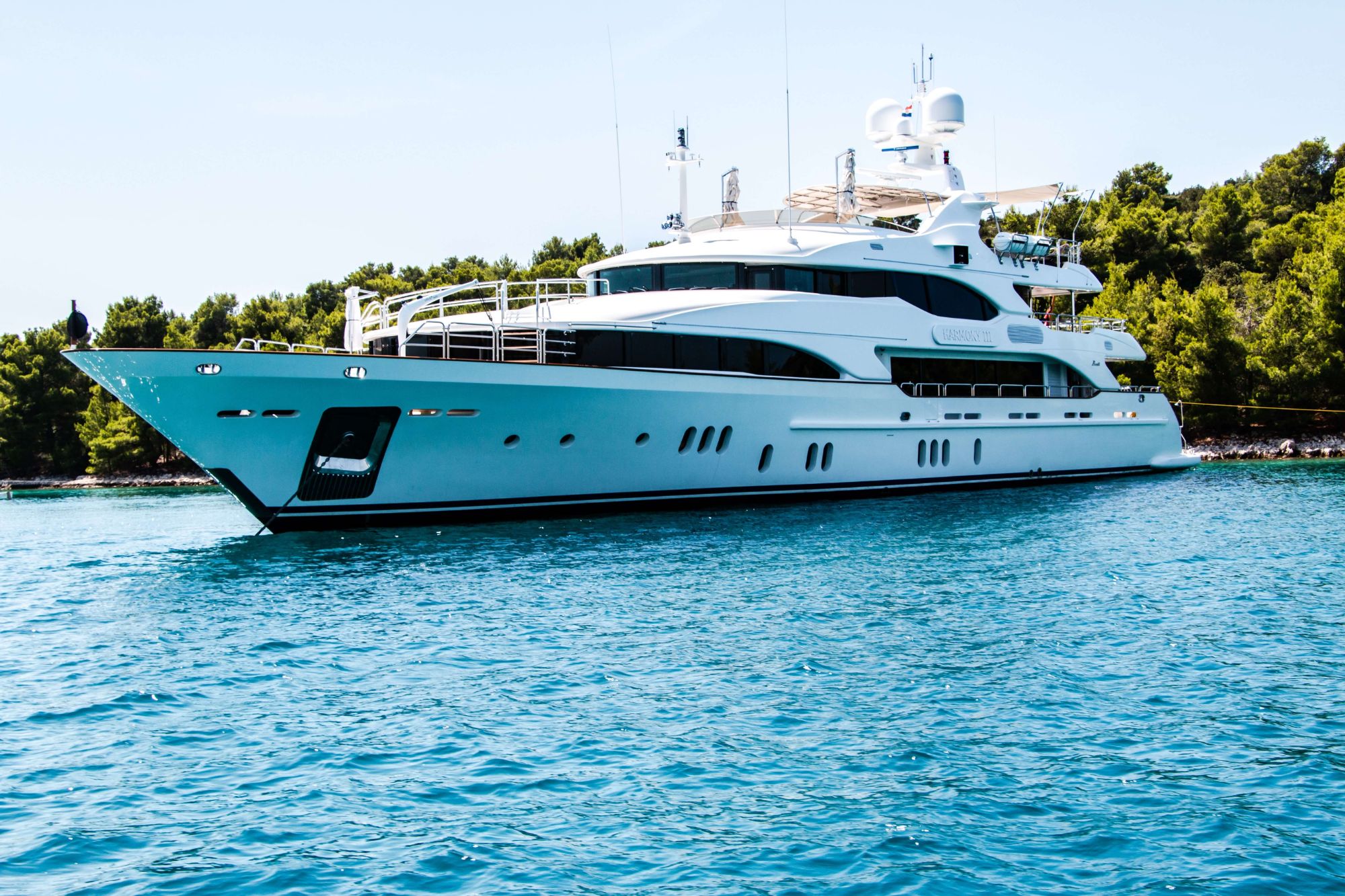
Pros of Motor Yachts:
- Powerful and fast
- Greater technological advances
- Greater deck space, more living volume
- Easier to find suitable crew members
- Easier to operate than a sailing yacht
- Easier to host guests of all personalities
Contras of Motor Yachts:
- Less sustainable, higher fuel consumption
- Less adventurous feel (if you are looking for it)
- Shorter range (can only be powered by motor)
- Engine noise
Motor yacht is probably the first thing which comes to your mind when you think superyachts.
Classy and sleek design, plenty of deck space, comfortable staterooms and lots of entertainment options – all this you can find aboard a motor yacht.
Motor yachts come in different types and sizes and with different purposes. The latest trend is explorer motor yachts, which are explicitly equipped for cruising in cold polar regions.
Yacht Types: Sailing Yachts
Sailing yachts are the second most popular yacht type. If you love the wind and want that classy sporty feel while aboard, then a sailing yacht is the right yacht type for you.
Another advantage is that when not powered by motor, sailing yachts are very quiet. It is only the sound of waves and wind (and an occasional seagull) around you.
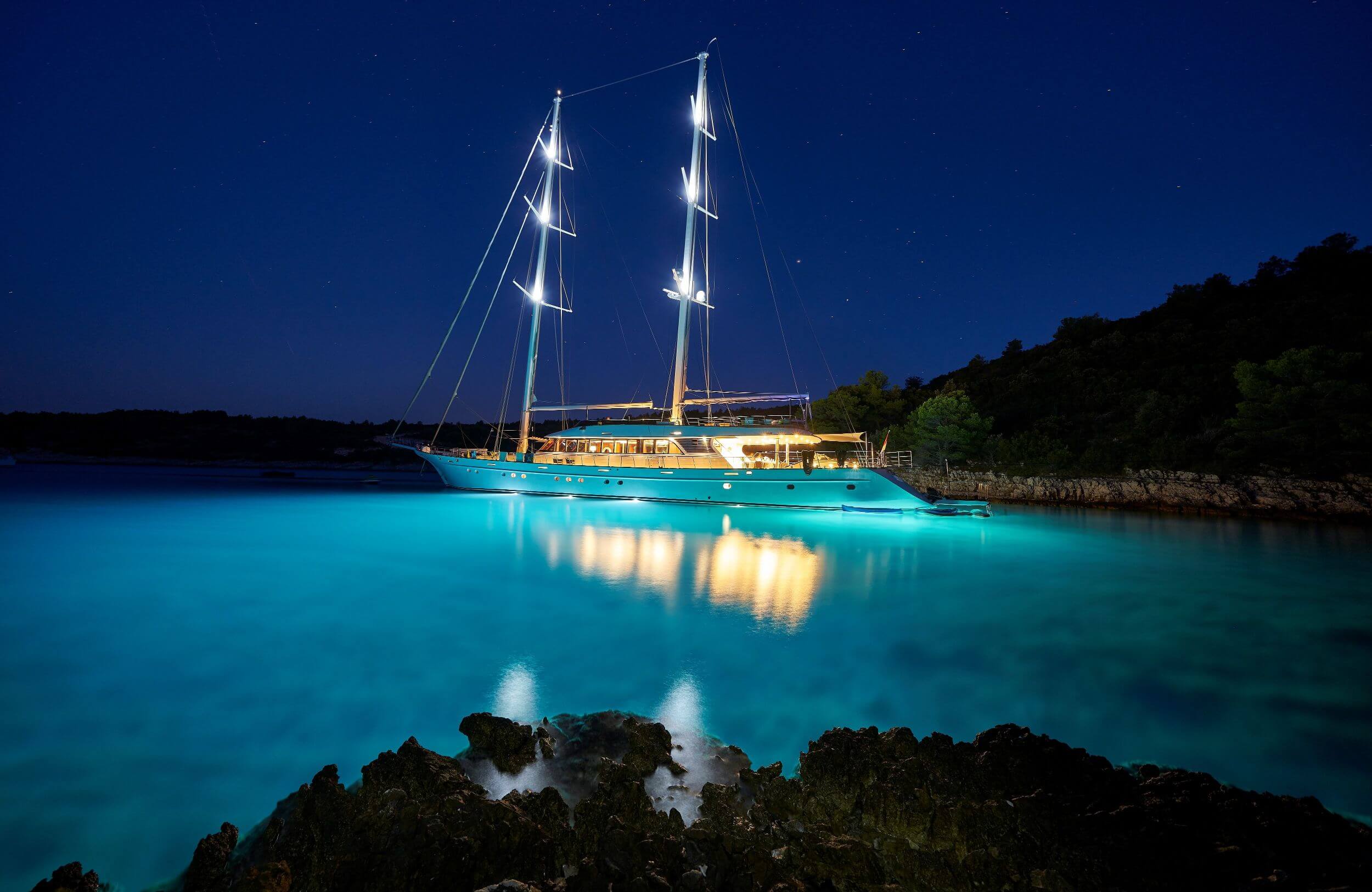
Pros of Sailing Yachts:
- Unique feel of adventure
- Can combine peaceful cruise with racing
- Very quiet when powered by sail
- Lower fuel consumption
- Lower maintenance cost
- Can sail in shallower waters
Contras of Sailing Yachts:
- Tend to be slower that motor yachts (in case you like speed)
- Less stabilization
- Smaller cabin space
- Might have less lifestyle equipment available (Jacuzzi, gym, cinema) …
There are only two types of people out there: sailing yacht fans and motor yacht fans. Rivalry between fans of the two yacht types has become legendary.
Probably, you already know which group you belong to. Nevertheless, we still recommend you charter both sailing and motor yachts to be sure you are making the right choice. If you are still unsure, read about the third yacht type below.
Yacht Types: Catamarans
Catamaran is defined as a vessel with two parallel hulls which are joined together. Due to its form, catamaran is the most stable of all yacht types.
If you are looking for stability and comfort, or have family members who easily get seasick, buying a catamaran is a valid option to consider.
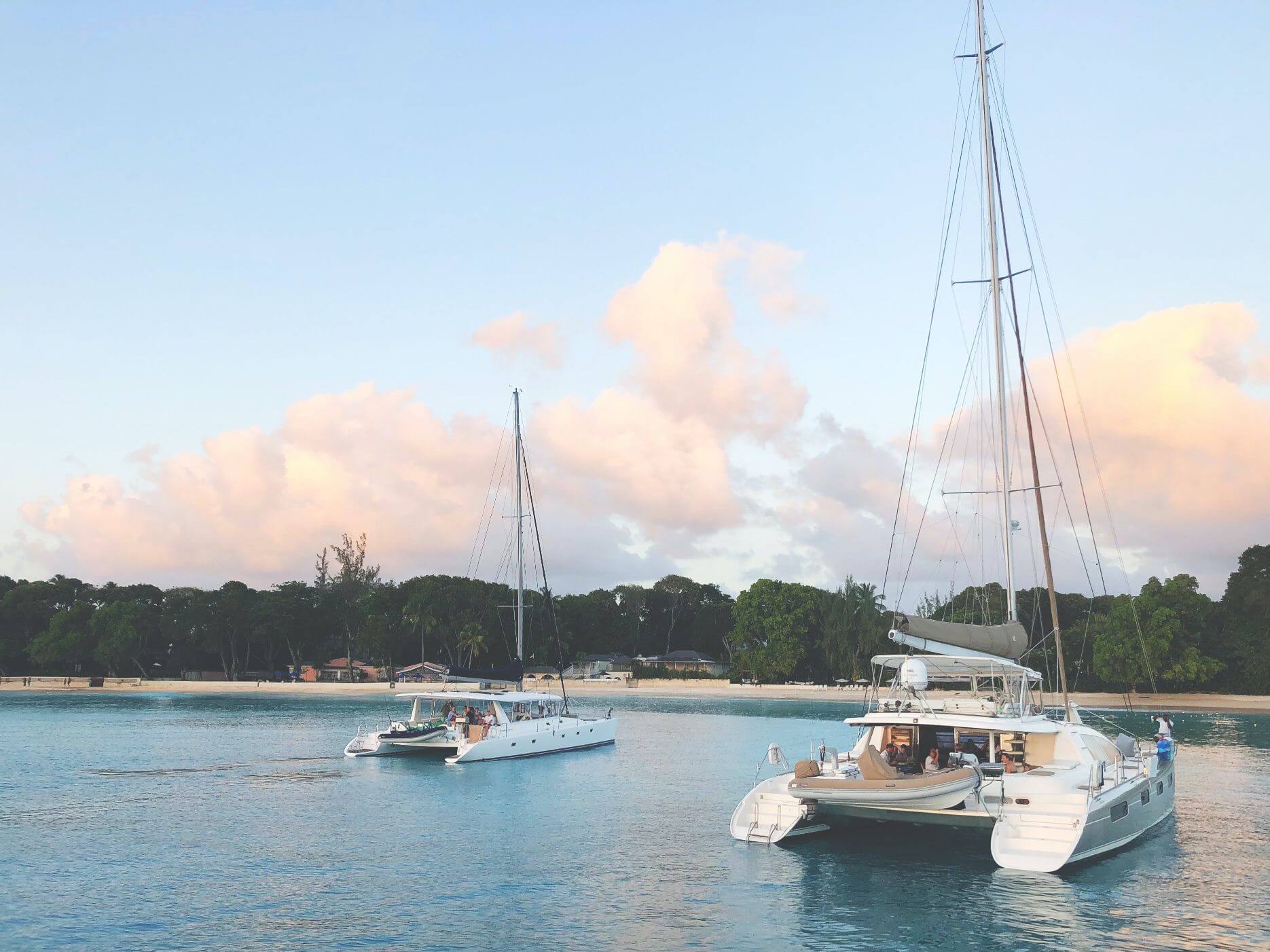
Pros of Catamarans:
- More fuel efficient & sustainable
- More stability
- Can be used in shallow waters
Contras of Catamarans:
- Less volume for staterooms
- Higher dockage rates than for a monohull
- Different sailing feeling compared to a sailing boat
Catamarans offer a great opportunity for taking family vacations, which will leave every family member happy. Since they are more difficult to sink, they are also considered the safest boats.
If you are looking for extra stability, comfort and space, but also do not want to compromise on adventures and possibility to explore shallow waters, catamaran is right yacht type for you.
Yacht Types: Trimarans
Big brother of a catamaran, a trimaran, has even three hulls – one main hull in the center, and two smaller hulls on each side.
You will not see them as often, but there are certainly also big fans of trimarans out there. Trimarans are designed for racing or leisure but are also widely used for military and shipping purposes.
YACHT PRODUCTION TYPES: SERIAL, SEMI -CUSTOM, CUSTOM YACHTS
Now that we’ve covered yacht types, let’s investigate which production options are out there. Unlike the automotive industry where most of the car models come from production lines, the yachting world offers future owners more possibilities.
SERIALS YACHTS
This is the most common and less expensive way to get to your new dream boat. Serial or production yachts are yacht models which are produced by shipyards in various quantities based on model and size.
Serial does not mean that you cannot tune it to your taste though. Manufacturers offer different sets of modifications with certain yacht models. You will likely get to choose between several layout models and different equipment options.
Obviously, if you order a newly build yacht, you are likely to get more space for your improvements, than if you decide to refit an already existing yacht.
SEMI-CUSTOM YACHTS
A good way for owners who wish more character and comfort to their boats but at the same time do not want to order a fully customized vessel, is to order a semi-custom yacht.
Semi-custom yachts stand between serial and fully customized boats. You save a lot of time and effort by picking an existing engineered platform from which to start planning.
Then, together with experienced naval architects and designers, you enhance it up to your expectations by customizing layout (possibly including superstructure) and interiors.
Ordering a semi-custom yacht gives you more freedom to decide how your yacht will look like. Construction time is also much shorter in comparison with a fully customized yacht, since many parts are already designed, engineered and possibly even pre-built.
By ordering a semi-custom yacht, you can shorten construction time from two – three years up to several months!
Shipyards are also less likely to fall behind the delivery schedule, since they have produced similar yachts before and know which time is needed for delivery.
Most semi-custom yachts are designed to suite majority of potential future owners, which means that layout, size, engineering etc will be well thought-through in advance.
Due to extensive previous testing & refining of semi-custom hulls by the shipyard, it is possible that your new yacht will turn out more reliable and problem-free than a fully customized yacht.
CUSTOM YACHTS
If you wish to be unlike anybody else and want to take your dream a step further, a fully custom-built yacht is exactly what you need.
Almost anything is possible and achievable in today’s superyacht building industry. The only considerations are your budget and international safety and security standards, more on which you can read in our article on Safety and Security Onboard Superyachts.
With a custom-made yacht, you can be sure you will get exactly the boat you want, tailored just for your preferences, no other yacht in the world being similar.
Consider longer delivery time and substantially higher cost, since R&D expenses are not shared between yachts of the same series.
Many owners buy a smaller replacement yacht, while they are waiting for their customized dream boat to leave the docks.
A fully customized superyacht is surely the most exclusive type of a yacht one can own.
Yacht Sizes
Now let’s look at different yacht sizes. But first, let’s find out what yacht size actually is.
How is yacht size measured?
Length Overall (LOA) is the most widely used metrics of yacht length. It is measured from the aftmost tip of the hull to the furthermost point of the stem, measured parallel to the waterline. It is probably the only yacht length definition you need to know as an owner.
*For yachting geeks out there, here are other yacht size definitions used in the industry:
Length of Deck (LOD) : deck length excluding bow sprits and other projections. Makes particular sense for sailing boats, since their Length Overall can considerably vary from their Length of Deck.
Length of Hull (LH or LOH): Length of hull including fixed fendering but excluding any bow sprits. It can be shorter than LOA.
Length of Waterline (LWL): length of a boat at the level where the boat sits in the water.
Interesting fact: Did you know that with each additional 1 meter of length, the internal volume of a yacht increases by 6-7 cubic meters? A 40-meter yacht is not just twice longer than its 20-meter companion. According to Cube Law, it is also 6-7 times larger in volume!
Motor yacht sizes by group
Let’s look at different sizes of motor yachts. To make things easier, we divided them into 4 groups.
Please note that the following crew and guest numbers per yacht size are only approximate.
Factual crew numbers will depend on specific yacht length, cruising style, owner preferences and whether the yacht charters or not.
Factual guest numbers will depend on yacht registration type, especially with larger yachts.
22 – 40 meter motor yachts
Motor yachts in of this size are most likely serial production yachts. This means that you can buy a specific yacht model which has been designed before, and choose your own details, such as finishings and furniture.
Yachts of this size will need 4-6 crew members: yacht captain, one or two deckhands, one or two stewardesses, a yacht chef, and presumably an engineer.
22-40 meter long motor yachts normally can host up to 8 guests.
40-60 meter motor yachts
Motor boats of 40 meters length and larger are considered superyachts also within circles of superyacht industry professionals.
This is where operations and crew requirements become considerably more sophisticated. There are also more semi-custom and custom boats in this size segment.
A 40-50 meter motor boat will require a crew of approximately 9-13 crew members, depending on specific owner requirements and cruising / charter preferences.
A possible crew setup would be: yacht captain, first officer, bosun, two engineers, three or two stewardesses, two deckhands, one or two chefs (often a guest and a crew chef).
Crew of a 60 meter motor yacht will count around 20 members.
40-60 meter long motor yachts normally can host up to 12 guests.
60 – 80 meter motor yachts
Here the yachts grow much larger, and so do the costs of maintenance.
A yacht of 60 meters length will have a crew of 20-23 members. A yacht of 80 meters length can have a crew of up to 80 members.
The maximum number of guests will depend on yacht registration type. Many owners choose to keep maximum of 12 guests, since it allows for a simpler regulation regime.
80 – 180 meter motor yachts
A 100 meter motor yacht will require 80-100 members crew. Its tonnage will exceed 500 GT, which means that the yacht will fall under more regulations: STCW, SOLAS, ISSC, ISM and others.
A 170 meter motor yacht can have up to 100 crew members.
The largest yacht worldwide at the time of writing is Azzam, at 180 meters built by Lürssen. Azzam can host 36 guests and a least 80 crew.
Maximum guest number on a yacht of this size can still be only 12 guests. But if the yacht is registered as a passage vessel, it can be significantly more.
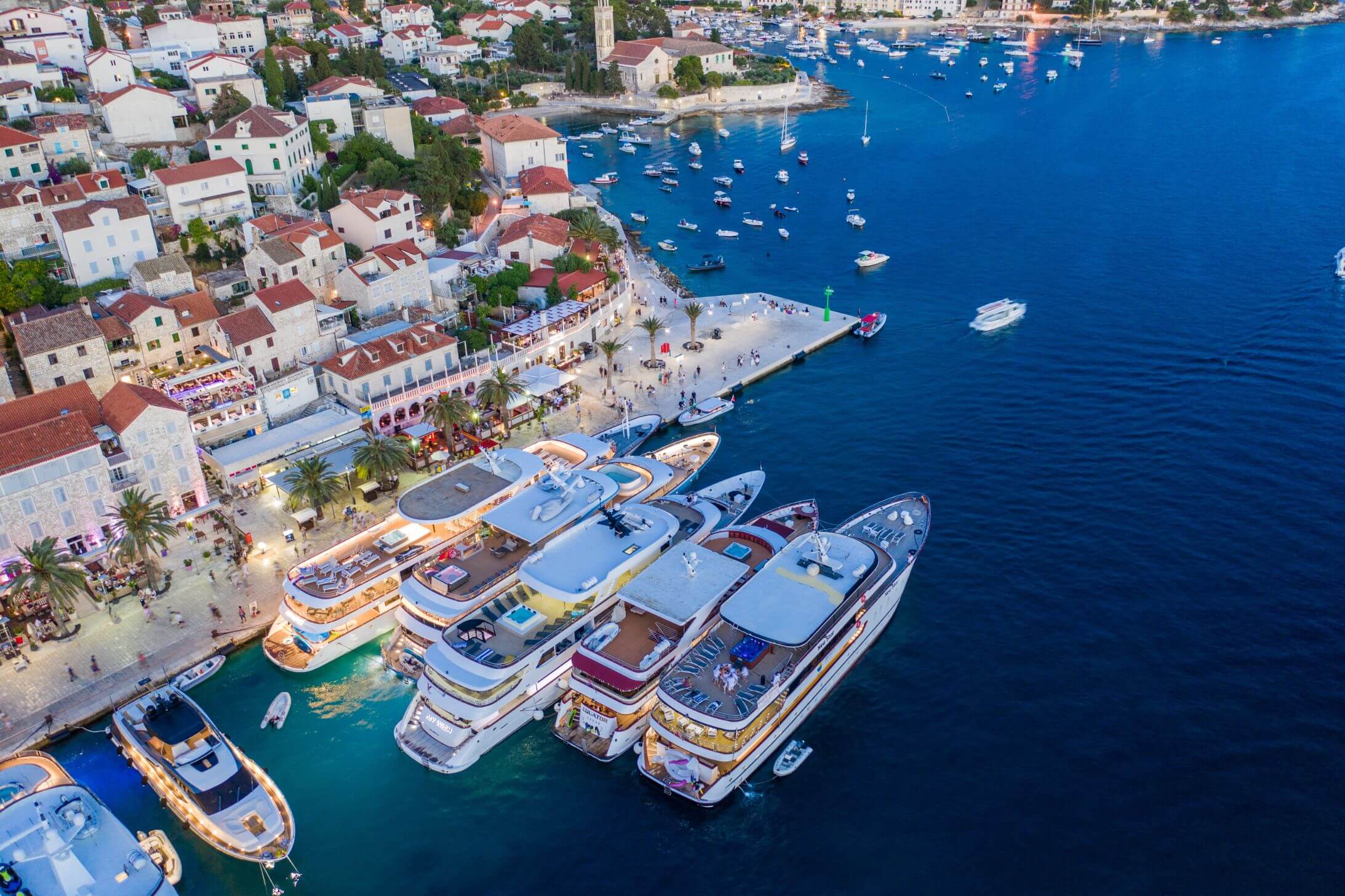
How does yacht size affect my yachting experience?
Size does matter after all.
Let’s look at factors that change with the growing size of a yacht.
While thinking of upgrading to a bigger vessel, do not forget that as the yacht size grows, following factors also increase:
- Yacht price
- Availability and price of marina dockage
- Fuel consumption
- Number of full-time crew members
- Time you can spend away from ports
- Quantity of water and other supplies the yacht can carry
- Functionality and entertainment options
- Complexity of repairs
- Applicability of laws & regulations
- Time needed to sell the yacht
Budget is the main factor which determines how big your boat can be. To learn more about the cost of yacht ownership, read this article.
During the past decade, superyachts increased in size dramatically, and this trend continues. According to an article by Boat International, there has been around 10.000 yachts over 24-meter LOA in the world. Around 80% of them were motor yachts.
Most of the owners start small and upgrade their boats over years. Once you owned a smaller yacht for some time, you will understand exactly what you love about it.
Also, you will know what you want to improve. So why not initiate a new-build of a new more exciting and possibly larger boat? You can still have the older yacht at your disposal, while waiting for the new delivery.
SUMMARY: YACHT TYPES AND SIZES
In this article, we classified all yachts into 3 main types: motor yachts, sailing yachts & catamarans. We also discussed their pros & contras.
We explained the difference between serial production, semi-custom and custom yachts.
Finally, we learned how yacht size is measured and how it affects various aspects of yacht operations. We looked at crew and guest numbers for each yacht size.
Another important factor to consider is whether you want to commission a new-built yacht or buy a second hand one . More on this in our next article .
Drop us an email if you need help with choosing a yacht or booking a yacht charter. We will define your needs and find the best solution together.
Are you a motor yacht, sailing yacht, or catamaran fan?
Comment below!
Article by Olympiada Wohlin-Elkovsky from Yachtowner.co
More Articles
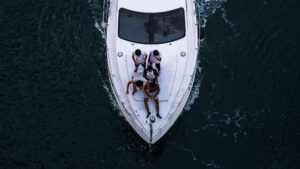
Superyacht Websites List
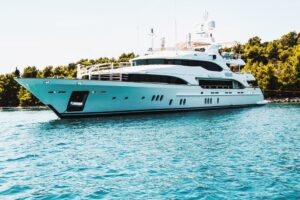
How to Buy a Yacht

Where to Buy a Yacht
Leave a reply cancel reply.
Your email address will not be published. Required fields are marked *
Save my name, email, and website in this browser for the next time I comment.
Yes, add me to your mailing list
Privacy Overview

How Long Are Yachts? Here’s What You Need To Know
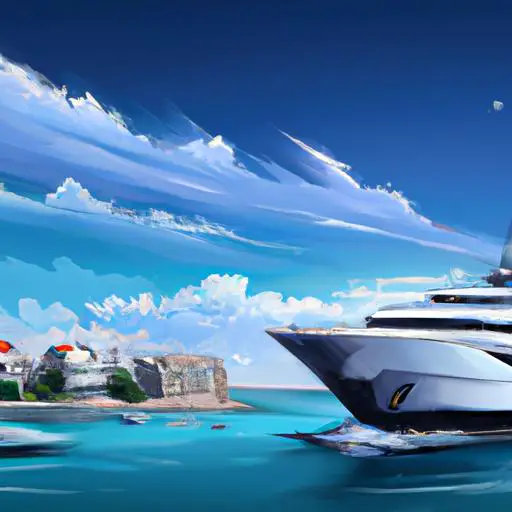
Whether youre looking to buy a yacht or just curious about their sizes and shapes, it can be difficult to know where to start.
But dont worry, because were here to answer all of your questions about yacht lengths.
In this article, well cover the different types of yachts, their average lengths, the factors that affect their lengths, how to measure their lengths, the difference between yacht length and beam, the pros and cons of different yacht lengths, and custom-built yachts.
So, if youve ever wanted to know how long are yachts, read on to find out!.
Table of Contents
Short Answer
Yachts can vary in length from just a few meters to well over 100 meters.
The exact length of a yacht depends on the type and class of yacht, as well as the purpose it is built for.
Small yachts are often used for day trips and can range from 8-20 meters in length, while larger yachts are used for longer voyages and can range from 20-100 meters in length.
Superyachts, which are typically used for luxury cruising, can range from 30 meters to over 150 meters.
Types of Yachts
Yachts come in a variety of shapes, sizes, and styles, each designed for a specific purpose.
From small day-cruisers to large superyachts, there is a yacht for every type of boater.
Smaller yachts range from 25 to 50 feet in length, and are typically used for day trips and watersports.
These vessels are generally equipped with the necessary amenities for a comfortable day on the water, including a cabin, restroom, and kitchenette.
Larger yachts, from 50 to 100 feet in length, usually feature more luxurious amenities such as multiple cabins, larger galleys, and spacious seating areas.
These vessels are designed for extended cruising, and are often used for family vacations and entertaining guests.
The largest yachts are known as superyachts, and range in length from 100 to 200 feet or more.
These vessels are often custom-built, and come with all of the amenities of a large luxury home, including multiple staterooms, elegant salons, and state-of-the-art entertainment systems.
Superyachts are used for global cruising, and can accommodate large groups of guests in style and comfort.
Finally, there are custom-built yachts, which can be of any size.
These vessels are designed to the owners exact specifications, and can be as large or as small as the budget allows.
Custom-built yachts are often the most luxurious and expensive of all, as they are tailored to the owners exact needs and tastes.
No matter what type of yacht you are looking for, there is sure to be one that fits your needs and budget.
From small day-cruisers to large superyachts, there is a yacht for everyone.
Average Yacht Lengths

When it comes to the size of a yacht, there are a number of factors that can influence the overall length of the vessel.
Generally speaking, yachts come in a wide range of sizes, with the average length being around 40 80 feet.
Smaller yachts, such as day-sailers, typically range in length from 25 45 feet.
Mid-sized yachts, such as cruisers and cabin cruisers, generally range in length from 45 75 feet.
Larger yachts, such as luxury motor yachts, tend to range in length from 75 150 feet.
The largest and most luxurious yachts, known as superyachts, can be up to 200 feet in length, depending on the size of the vessel and the preferences of the owner.
Of course, these sizes are just averages and there are yachts of any length available for purchase.
Custom-built vessels can be designed and constructed to meet any need, from small day-sailers to huge superyachts.
Whatever your budget and preferences, there is a yacht to suit your needs.
Factors Affecting Yacht Lengths
When it comes to yacht lengths, there are a variety of factors that come into play.
The size of the yacht is largely determined by the type and purpose of the vessel, as well as the budget and preferences of the owner.
For example, larger yachts are typically used for extended cruising and luxury vacations, while smaller boats are often used for day trips and watersports.
Additionally, custom-built yachts of any size can be purchased, depending on the owners budget and preferences.
Another factor that affects the size of a yacht is the type of water it will be used in.
For example, vessels designed for use in the ocean typically need to be larger and more durable than those designed for use in rivers or lakes.
Additionally, some yacht owners may opt for larger vessels to accommodate more passengers or guests, while others may prefer smaller vessels to save on fuel and storage costs.
The type of propulsion system used on a yacht also plays a role in its size.
Yachts that use an outboard or stern drive propulsion system typically require larger vessels than those with an inboard engine.
Additionally, the type of materials used to construct a yacht also affects its size, as some materials are more durable and require a larger vessel to accommodate them.
Finally, when it comes to yacht lengths, the design of the vessel also needs to be taken into consideration.
Yachts can be designed to have one or more decks, and the size of the yacht will depend on the number of decks and the overall design of the vessel.
Some yachts may have multiple levels and decks, while others may only have one.
In conclusion, there are a variety of factors that affect a yacht’s size, from the type and purpose of the vessel, to the budget and preferences of the owner.
Additionally, the type of water it will be used in, the type of propulsion system, the materials used to construct the yacht, and the overall design of the vessel will also play a role in determining its size.
With custom-built yachts of any size available for purchase, yacht owners have a variety of options when it comes to choosing the perfect vessel for their needs.
How to Measure Yacht Lengths

Measuring the length of a yacht can be a complicated process as different yachts come in different shapes and sizes.
Generally, yacht lengths are measured from the tip of the bow (the front of the boat) to the stern (the back of the boat).
Depending on the type of yacht, this measurement can also take into consideration the yachts bulwarks, which are the rails that run along the sides of the boat, as well as its swim platform, which is the area at the back of the boat where people can enter and exit the water.
When measuring a yacht, it is important to consider the LOA (Length Over All), which is the total length of the vessel including any appendages, such as outriggers, that may extend beyond the main hull.
Additionally, the LOD (Length On Deck) is the length of the yachts deck and superstructure, while the LWL (Length Water Line) is the length of the yachts waterline.
This is the length of the yacht that is actually in contact with the water and can be affected by the weight and trim of the vessel.
It is also important to note that not all yachts are measured in feet.
Some smaller yachts are measured in metres, with the length of the yacht typically being between 5 and 15 metres.
Additionally, some yachts may also be measured in tons, which is a unit of weight and not length.
No matter what type of yacht you are looking for, understanding the different measurements and terms used to describe yacht lengths is essential to ensure that you are choosing the right vessel for your needs.
By considering the yachts LOA, LOD, LWL, and other measurements, you can ensure that the yacht you choose is the right size and shape for your intended purpose.
The Difference Between Yacht Length and Beam
When discussing yacht sizes, it is important to understand the difference between length and beam.
Length is the measure of a yachts overall length from bow to stern and is usually expressed in feet.
Beam, on the other hand, is the measure of a yachts greatest width from side to side, and is usually expressed in meters.
The larger the beam, the more spacious a yacht is, and the more comfortable it is to live aboard.
Beam measurements are especially important when considering larger yachts, as it determines the amount of space available for cabins, staterooms, and other amenities.
For example, a yacht with a beam of 6.
5 meters will be much more spacious than a yacht with a beam of 4 meters, even if they have the same length.
Likewise, a yacht with a beam of 10 meters is likely to have many more amenities than one with a beam of 5 meters.
The Pros and Cons of Different Yacht Lengths

When considering the size of yacht you’d like to purchase, it’s important to understand the pros and cons associated with different yacht lengths.
Smaller boats are typically more affordable, but they may not have the same amenities and features as larger yachts.
On the other hand, larger yachts are more expensive but they provide more space, comfort, and luxury.
For those who are looking for a day-use vessel, a smaller yacht of 25 feet or less is a great choice.
These boats are typically designed for watersports and short trips, and they are often more affordable than larger boats.
Additionally, small yachts are easier to maneuver and require less maintenance.
Mid-size yachts, from 30-60 feet in length, are ideal for those who want more space and comfort.
These yachts can accommodate more passengers, and they often come with luxury amenities such as a kitchen, bathroom, and sleeping quarters.
Mid-size yachts are also great for those who want to go on longer trips, as they offer more space and comfort than smaller boats.
Large yachts, from 60-200 feet in length, are the ultimate luxury vessels.
These boats are expensive and require a great deal of maintenance, but they provide the ultimate in comfort and luxury.
Large yachts are ideal for extended cruising and luxury vacations, and they come with a range of amenities such as a full-service galley, multiple bedrooms, and even a spa.
Finally, custom-built yachts of any size can be purchased for those who want a yacht that is tailored to their exact specifications.
Custom-built yachts require a significant investment, but they are perfect for those who want a unique, personalized experience.
Ultimately, the size of yacht you choose will depend on your budget and preferences.
Smaller boats are more affordable and easier to maintain, while larger yachts provide more space and luxury.
Custom-built yachts are ideal for those who want a yacht that is tailored to their exact specifications.
No matter what size yacht you choose, it’s important to do your research and understand the pros and cons associated with different yacht lengths.
Custom-Built Yachts
When it comes to yachts, size matters.
Whether youre looking for a luxurious cruiser or a smaller day-trip boat, custom-built yachts offer a range of options to suit any need.
Custom-built yachts come in a variety of sizes, with larger vessels typically ranging from 85 to 200 feet in length.
Smaller boats, such as those used for day trips and watersports, are usually between 25 and 50 feet in length.
When selecting a custom-built yacht, the size of the vessel will depend on the purpose of the boat, the budget of the owner, and their preferences.
A larger yacht is ideal for extended cruising and luxury vacations, while smaller boats are better suited for shorter trips and watersports.
For example, a superyacht of 200 feet or more can accommodate a large number of guests, and provide luxurious amenities like multiple decks, hot tubs, and cabins.
In contrast, a smaller boat of 25 feet can be great for a day trip, with plenty of space to move around, and a range of watersport activities available.
Additionally, custom-built yachts can be built to any size, depending on the owners specifications.
With the help of experienced industry professionals, any size yacht can be constructed to meet the owner’s exact needs.
The size of the yacht will also determine the cost, with larger boats typically costing more than smaller vessels.
In conclusion, the size of a yacht depends on the type and purpose of the vessel, the budget of the owner, and their preferences.
Custom-built yachts can be constructed in a range of sizes, from small vessels of 25 feet in length, to large superyachts of 200 feet or more.
No matter what size yacht youre looking for, a custom-built vessel can be designed to fit any need.
Final Thoughts
No two yachts are exactly the same, and the length of a yacht depends on a variety of factors, from the type of yacht and the purpose it will be used for, to the budget and preferences of the owner.
Measurement of yacht length is an important factor to consider when making a purchase, as it will determine the size of the vessel and the activities that can be enjoyed on board.
Whether you prefer a smaller yacht for day trips or a larger one for luxury vacations, there is an option for every budget and every need.
So, how long are yachts? The answer depends on you.
James Frami
At the age of 15, he and four other friends from his neighborhood constructed their first boat. He has been sailing for almost 30 years and has a wealth of knowledge that he wants to share with others.

Recent Posts
When Was Banana Boat Song Released? (HISTORICAL INSIGHTS)
The "Banana Boat Song" was released in 1956 by Harry Belafonte. This calypso-style song, also known as "Day-O," became a huge hit and remains popular to this day for its catchy tune and upbeat...
How to Make Banana Boat Smoothie King? (DELICIOUS RECIPE REVEALED)
To make a Banana Boat Smoothie King smoothie at home, start by gathering the ingredients: a ripe banana, peanut butter, chocolate protein powder, almond milk, and ice. Blend the banana, a scoop of...
- Brokerage New Construction How to Buy How to Sell
- Yacht Fleet Yacht Catalog Charter Marketing Destination Guides
- Financial Services Payroll & Accounting Payroll Service Process Logistical Support Admin Services Crew Admin
- Job Descriptions Crew FAQ
- About Sitemap
Length Is Only One Measure of Luxury
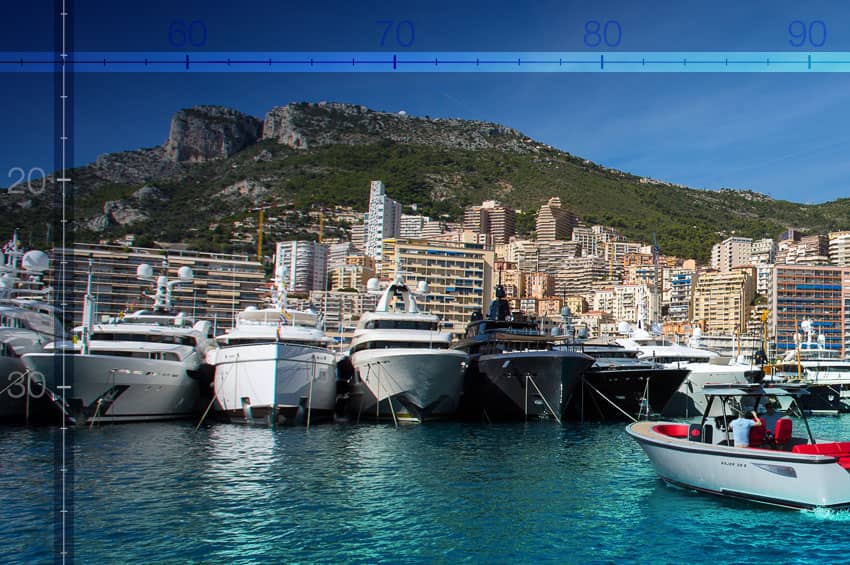
As the Yachting industry continues to expand the number of vessels in the mega and super yacht length categories, additional measures of dimension are often overlooked.
Crew aboard luxury yachts deal with the challenges of cooking, cleaning and maintaining on a daily basis are aware of the importance of internal volume. The ease of movement and workspace comfort are driven by measures in addition to LOA (length overall).
The key to making vessels of similar length “feel big” is internal volume. The internal volume is a function of length, breadth and height. In walking the docks, comparison of side by side vessels of equal length immediately identifies the variables of beam and height. Yachts between 40 meters and 50 meters could feasibly have equivalent internal volume dependent on beam and the number of decks.
Length in and of itself can be a deceptive figure. The point along the hull where length is measured can vary. Any point other than the load line can mistakenly include bow overhangs, swim platforms, rudder dimension. The beam or breadth of a vessel is also measured on the outside of the hull mid ship at the waterline.
How the length, beam and height are combined results in the actual internal volume and the feeling of size and comfort aboard. Internal layout and the integration of alfresco areas are design challenges to give guests the impression of a bigger yacht and add to the feeling of comfort. The addition of swim platforms and sundecks can also provide an illusion of more space to the guests.
While comfort and appearance are criterion for guests, crew are impacted by the internal volume in the ease of providing service to those guests. The galley and engine room are particularly critical areas for adding volume – both for ease of use and safety. Both areas can be less than hospitable even in yachts of super length.
Design of workflow, access, storage, and movement benefits from the addition of volume provided by additional beam. The design challenge in every yacht is to have adequate service spaces without compromising the size and comfort of guest cabins.
Internal volume is measured in gross tons (GT) displacement. The internal capacity has its origin in shipping. It quantifies all space available for cargo, crew, passengers, stores and mechanics. In the t shipping industry the space that remains after subtracting internal space for everything but cargo is the space available for cargo transport – the earning power of the vessel.
Internal volume not only gives the impression of a bigger yacht, but also contributes to the earning power of the yacht by enhancing ease of use for both guests and crew.
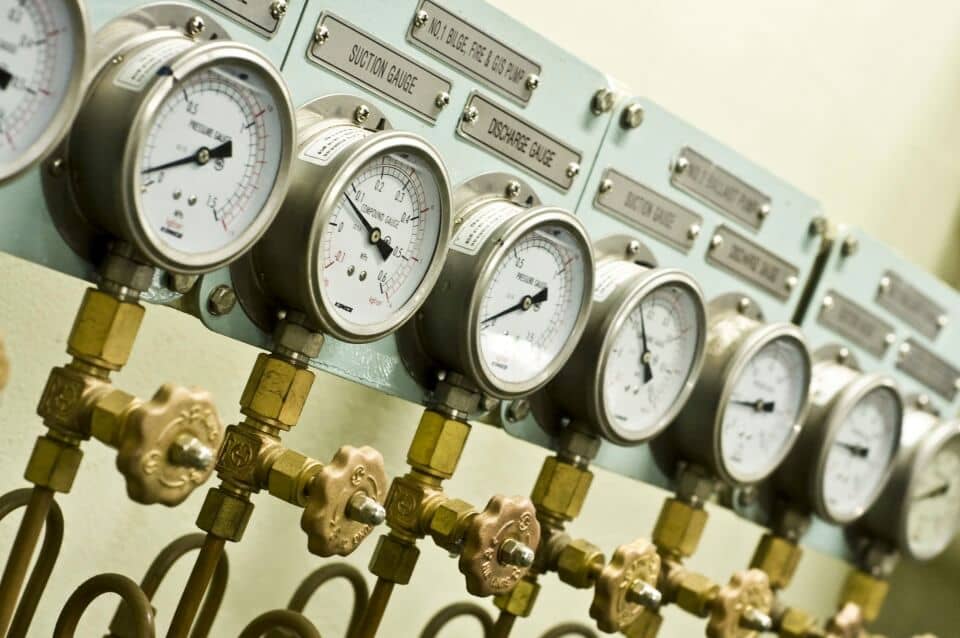
Engineering License Changes
The MCA has restructured the engineering certifications. The MEOL course has been done away with, and the AEC course made mandatory and more thorough. Luxury Yacht Group explains all these changes, what engineers progressing through the ranks can do now, and how Y ticket holders can convert their licenses over to the structure.
14 Mar 2018
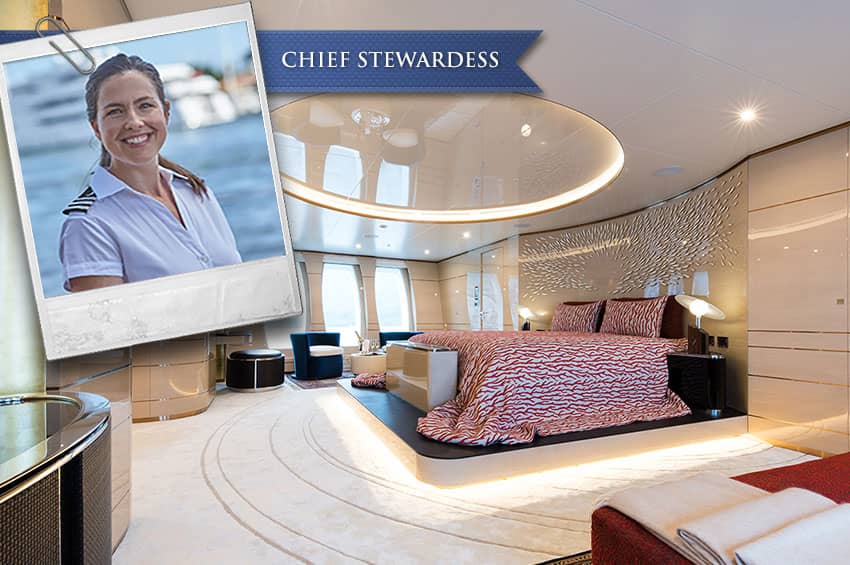
A Day in the Life Series – Chief Stewardess
For a yacht to run smoothly, it requires many working parts, and the interior department is a large component of this. The chief stewardess oversees this department and makes sure all the stewardesses onboard know what their tasks and responsibilities are. The interior department is largely in charge of the guest services whilst they are onboard, and responsible for interior maintenance of the yacht when they are not.
18 Dec 2017
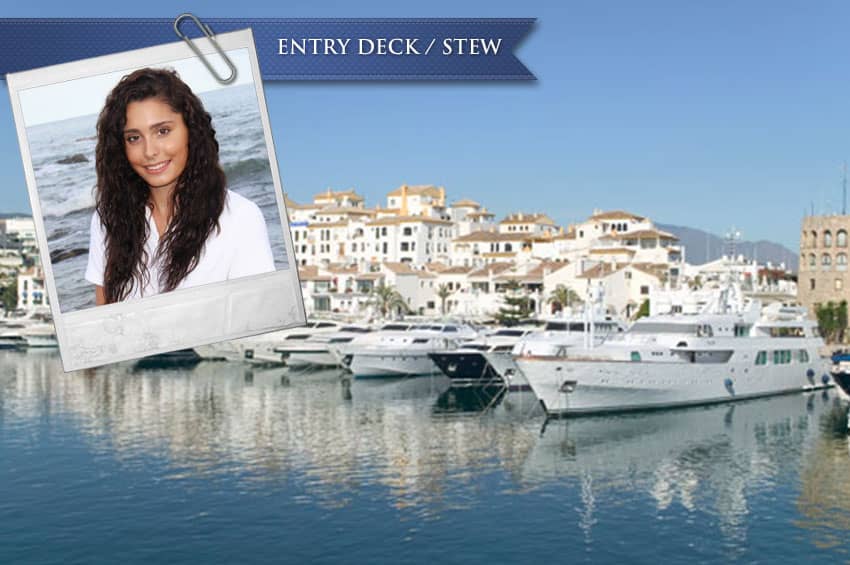
A Day in the Life Of Series - Entry Stewardess
Joining the yachting industry is an exciting and daunting undertaking. In this two part interview we speak with Melanie about why she decided to join the superyacht industry, what her hopes and goals are, and what she has learnt so far as an entry level stewardess.
29 Nov 2017
- San Lorenzo
- Yacht Rental in Dubai Marina
- Yacht Party Dubai
- Overnight Experience
- Formula 1 Abu Dhabi
- Corporate Events
- Fifa World Cup 2022
- Anniversary Celebrations
Connect with a yacht expert & get per personalised Deals

What Size is a Yacht
Yachts are boats used for leisure and are usually over 30 feet long. They come in different sizes; the more luxurious ones are between 30 and 60 feet, while the really big ones, called superyachts, are over 100 feet. Smaller boats for day trips are not yachts if they are less than 30 feet. Today’s article will discuss yacht sizes, dimensions, and classifications.

Yacht Sizes
To determine a yacht’s size, start by measuring from the front to the back end, which gives you the overall length. Remember, this measurement, known as length overall (LOA) , includes everything from the main deck to any forward-pointing parts or rear platforms.
The length of the part of the yacht that’s actually in the water is also measured, and it is called waterline length (LWL) . You must consider other dimensions, such as the width (beam) and how deep it sits in the water (draft). Yachts are weighed without any liquids on board to get the dry weight and with all liquids for the wet weight. If you add all the gear, you get the loaded weight.
Yacht Dimensions
How do yacht sizes impact their handling.

Yacht size significantly affects handling. Due to increased length and displacement, larger yachts have more momentum and take longer to respond to steering and power changes. They require more space to maneuver and have larger blind spots, especially under the bows. Smaller yachts are generally more agile and responsive.
Small yachts are easy to handle and quickly change direction, perfect for navigating tight spots. Larger vessels, such as explorer yachts built for long-distance travel, need careful steering and more time to slow down or stop. They often come with extra features like thrusters for precise control.
The yacht’s width, or beam, keeps it steady on the water; however, a wider yacht might not move as swiftly or turn as easily. The draft, which is how deep the yacht goes under the water, is deeper for better performance against the wind, but it means the yacht can’t go into shallow areas. The yacht’s height affects how much wind it can catch, which helps determine how far a yacht can travel and makes it more challenging to handle.
Yacht Classification
When you are looking to charter a yacht , buy one, or rent it for a getaway, picking the right size is essential. It is all about matching the yacht to what you need, whether that’s room for a big group, special features for comfort, or just the right feel.
The size you choose has a big impact on how easy the yacht is to handle, where you can take it, and how many friends or family can come along. In addition, it has got to fit your budget. Getting the size right means you will have a better time on the water and save money.

Choosing the Right Yacht Size – Final Words
In the world of yachting, size does matter. It influences everything from the yacht’s handling and maintenance to the overall onboard experience. Whether you are a seasoned sailor or a leisurely cruiser, understanding the dimensions and classifications of yachts ensures that you select a vessel that meets your needs and delivers the comfort and performance you desire.

Qazi Raza Ul Haq
My name is Raza and I am an experienced SEO content writer who loves to explore and seek adventure. I have over 8 years of experience in blogging and SEO content writing. I would be delighted to take you on a thrilling journey to discover the world of yacht rentals in Dubai, providing you with valuable insights and helpful tips.

PER HOUR Per Day
Browse our Yachts

- (954) 633-4878
- [email protected]
Gulfstream news
- February 2, 2024
Easy Guide to Understanding Yacht Sizes

Navigating the sea of yacht choices can feel as challenging as sailing the seven seas themselves. But don’t worry, because understanding the classes and sizes of these luxurious vessels is the first step in charting your course to the ideal maritime experience. Whether you’re looking to host grand soirees on the deck, embark on long tranquil voyages, or enjoy sporty adventures on the waves, there’s a yacht out there that’s perfectly sized for your needs and desires.
What Determines a Yacht’s Class?
The class of a yacht isn’t just about its length; it encompasses several factors that contribute to the overall experience. These factors include the yacht’s size, style, facilities, crew requirements, and intended use. Yacht classes can range from sleek, racetrack-ready vessels to floating palaces designed for opulence and comfort. Understanding the classification can help you visualize what life at sea could be like aboard these different vessels.
Size Matters: The Various Yacht Size Categories
Yachts typically fall into specific size ranges, each offering its own unique set of benefits and considerations:
- Day Sailing Yachts : Under 30 feet in length, these are ideal for casual trips close to shore.
- Weekender Yachts : Typically 30-40 feet, they offer basic cabins suitable for short stays.
- Cruising Yachts : Usually measuring 40-50 feet, these combine comfort and storage for longer voyages.
- Luxury Yachts : At 50-100 feet, they often come with indulgent amenities and can accommodate guests and crew.
- Superyachts : Exceeding 100 feet, these are the epitome of nautical splendor, with bespoke features and unparalleled luxury.
- Mega Yachts : Over 200 feet, these are the rarified realm of extraordinary custom features and space akin to a floating mansion.
Deciphering Size and Space: Understanding Tonnage
Contrary to what it sounds like, tonnage doesn’t refer to weight. Instead, in yachting terms, it represents volume, and it’s a critical component in understanding the size of a yacht. This measurement can provide insights into onboard space, which can be a better indicator of whether a yacht will suit your space needs than length alone.
The Day-to-Day of Yacht Life: Layout and Usability
Imagining yourself aboard is essential. Consider how the yacht’s layout will cater to your lifestyle. Does the deck have ample space for relaxation and social gatherings? Are the cabins configured for privacy and comfort? Is the galley equipped for gourmet cooking, or will simple fare suffice? Envisioning each area’s functionality will guide you toward the right yacht size.

The Crew Factor: How Size Influences Staffing
Operating a yacht is no small feat, and the larger the vessel, the more hands you’ll need on deck. From captains and chefs to engineers and stewardesses, understanding crew requirements is an integral part of yacht ownership. Not only does it impact the day-to-day running of the yacht, but it also affects the overall experience for you and your guests.
Navigating Through the Seas: Technological Considerations
Advancements in technology have transformed maritime navigation, but with larger yachts, the complexity increases. Sophisticated navigation systems, stabilizing technology, and communication equipment are just a few aspects that play a bigger role in larger yachts’ operations, requiring a crew that is well-versed in these modern marvels.
If These Decks Could Talk: Entertainment and Amenities
With size comes opportunity, and larger yachts bring the potential for more lavish entertainment and amenities. Are you dreaming of a cinema room, a gym, or perhaps an onboard spa? The spectrum of customization is virtually endless, allowing your seafaring sanctuary to be as unique as your imagination.
Exploring the World in Style: The Yacht as Your Oyster
Think of your yacht as a gateway to the world’s most exclusive locales, accessible only by sea. The array of destinations you can explore is as boundless as the ocean itself. Whether it’s the cerulean waters of the Caribbean or the hidden coves of the Mediterranean, the right yacht size empowers you to embark on these adventures with ease and elegance.
Anchors Aweigh: Making Your Dream a Reality
Once you’ve familiarized yourself with yacht sizes and what they entail, the voyage toward purchasing your dream yacht begins. Knowing which size aligns with your aspirations is crucial to ensuring a future filled with unforgettable maritime memories.
When you’re ready to explore the possibilities of yacht ownership, Fly Yachts’ experienced team is here to guide you. With a reputation as a leading yacht brokerage, we’re equipped with the knowledge and expertise to help you find a vessel that mirrors your vision of life at sea. Talk to a Fly Yachts team member today and let us help you navigate your journey to the perfect yacht.

Navigating the world of yachting is easy with Fly Yachts by your side. Their yachts for sale page is a treasure trove of luxury yachts, from grand super yachts to versatile center consoles ready to hit the seas. If bespoke is your preference, the Build a Yacht feature allows you to customize a yacht to your liking. The About Us page gives insight into the company’s expertise and customer-focused ethos. Vacation seekers can sail away using Yachts Charter services and select the perfect seascape with Charter Destinations . For yacht owners ready to sell, the Sell Your Yacht service streamlines the process. Broaden your yachting insights with the well-crafted Compass Articles and stay current with Gulfstream News . Air travel aficionados will find the Aircraft for Sale page well-stocked with flying luxury. Have queries or need to reach out? The Contact page is there for just that. To discover the full breadth of offerings, start with the Homepage and chart your course in the world of yachts.
About FLY Yachts
Recent posts.
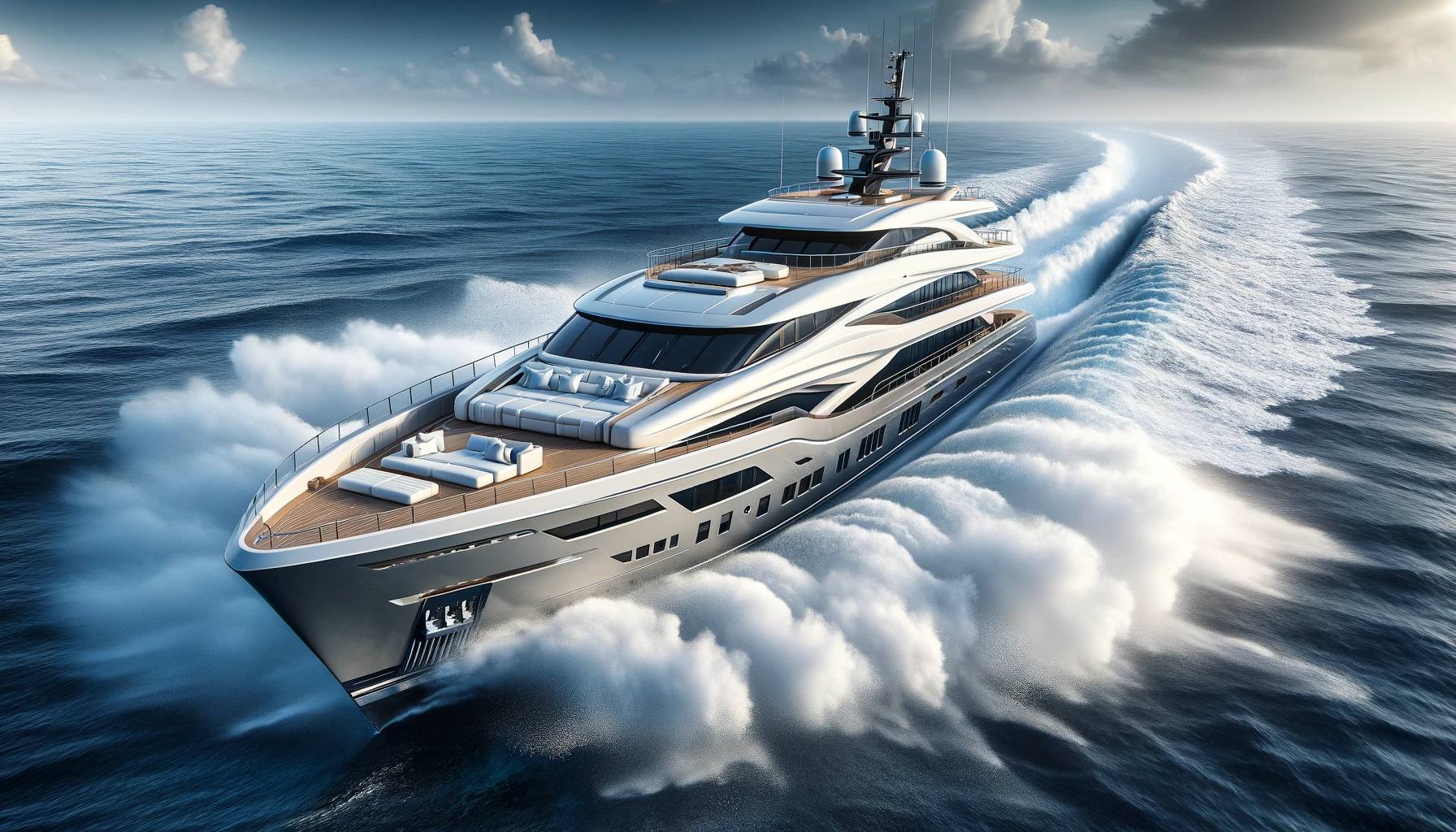
Tech Trends: The Latest Marine Electronics for Yachts
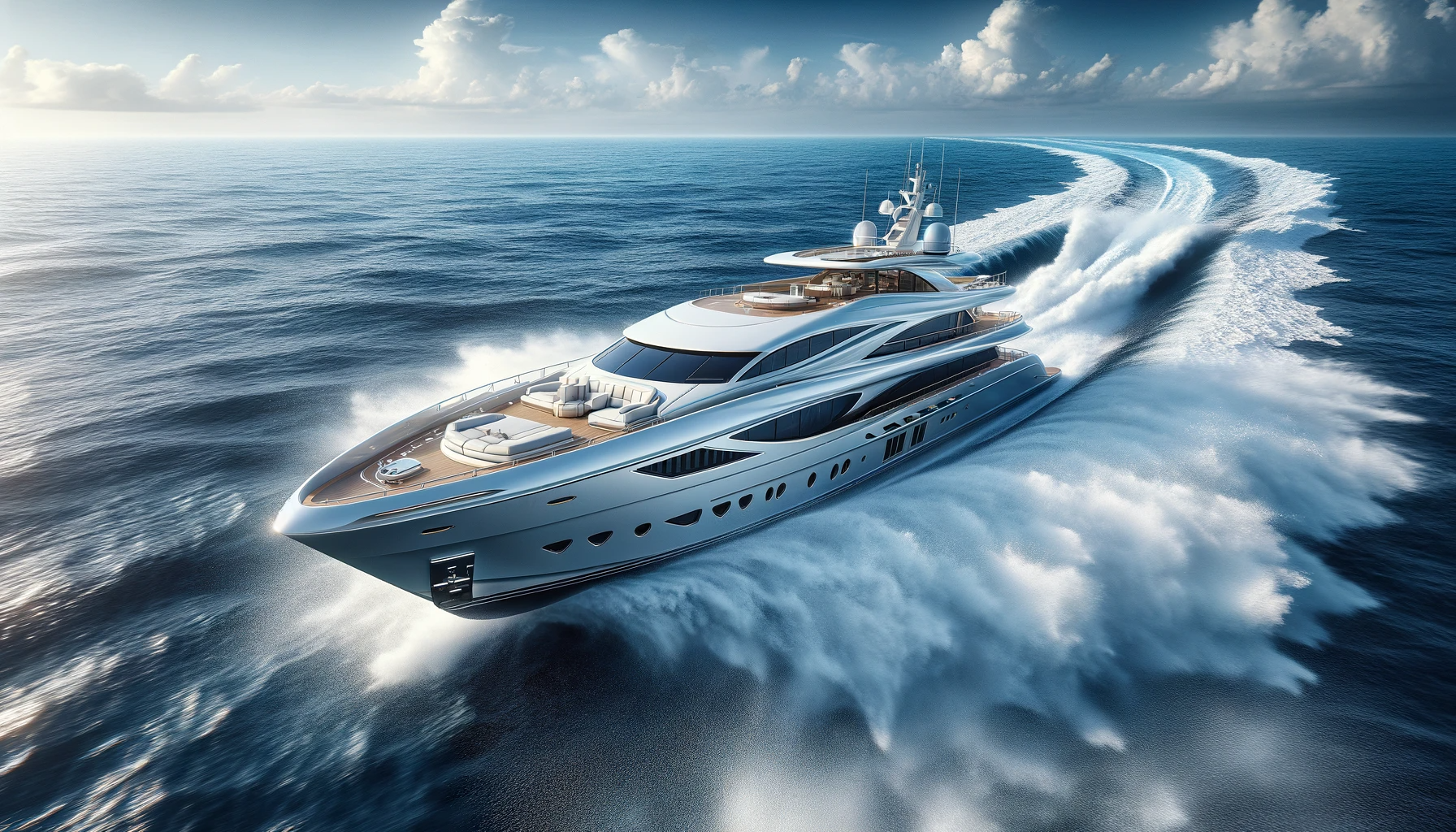
Sailing with the Wind: Insights into Yacht Sail Systems

Eco-Friendly Yachting: Sustainable Innovations in Yacht Design


Boating Basics Online is reader-supported. When you buy via our links, we may earn a commission at no cost to you. Learn more
How Are Boats Measured? (Length, Width & Height)
Written by J. Harvey / Fact checked by S. Numbers
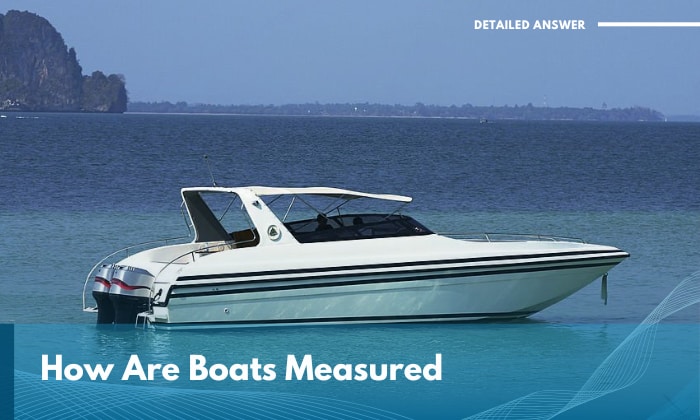
The length of a boat will always be one of its most important aspects because it overlaps numerous essential factors every time you take it out to sea.
As far as the question “How are boats measured?” is concerned, we don’t depart from the fundamentals like knowing its exact length, width, and height.
The significance of knowing the exact boat length measurement is proven by the need to know the vessel’s length overall, length on deck, and waterline length, to cite a few. These are often tallied in order to adhere to regulations and other important considerations.
Read on to find more about the correct way to measure a boat.
Table of Contents
The Different Ways Boats Are Measured
1. overall length, 2. length on deck, 3. waterline length, why are the measurements of a boat important, what device is used to measure a boat.
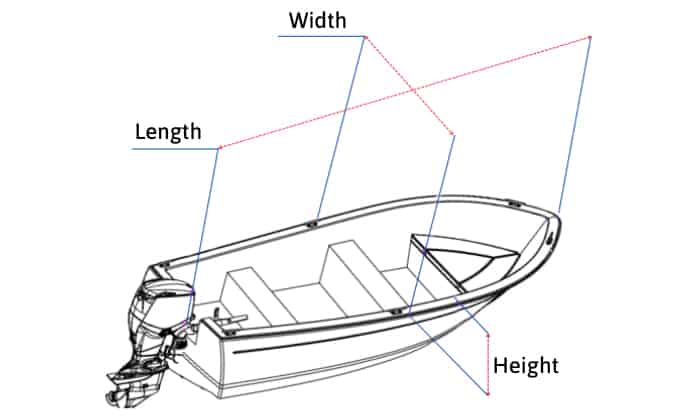
To know how to measure a boat thoroughly, we have to look at both the units that need to be measured and the ways to calculate and quantify them. These are the main parameters you have to look at:
- Length – This unit often takes the spotlight because it includes critical elements such as length overall, length on deck, and waterline length. It’s also what helps to determine boat classifications.
- Width – To measure the width of a boat is to know its beam, which is its upper surface’s widest extent. The average width of a boat is 8 fee
- Height – This is concerned with the distance between the beam’s highest point up to the bottom-most portion of the hull. It could also refer to the freeboard or the distance between the deck and the waterline.
Height (what builders refer to when they measure the depth of a boat) also determines draft (the distance between the waterline and the bottom of the vessel). To elaborate, the taller the boat, the more draft it’ll require to run smoothly.
Length is the more prominent of the three, though. After all, an operator measure the length of their vessel to get vital measurements such as the following:
- Length Overall (LOA) – Most state laws require knowledge of this exact parameter not only to identify the vessel’s true size but also the amount of boating and safety equipment it needs to have onboard. It also influences the vessel’s performance and speed , among others.
- Length on Deck – This is often confused with the length overall (LOA). However, usually, this only accounts for the (you guessed it!) deck’s length and leaves out the protrusions.
It can also be used to approximate boat dimensions and, thus, its total size, though.
- Waterline Length (LWL) – This refers to the vessel’s length with regard to its current waterline. As such, it accounts for the submerged portion of the hull only, so LWL will typically be shorter than LOA.
How to Measure the Length of a Boat
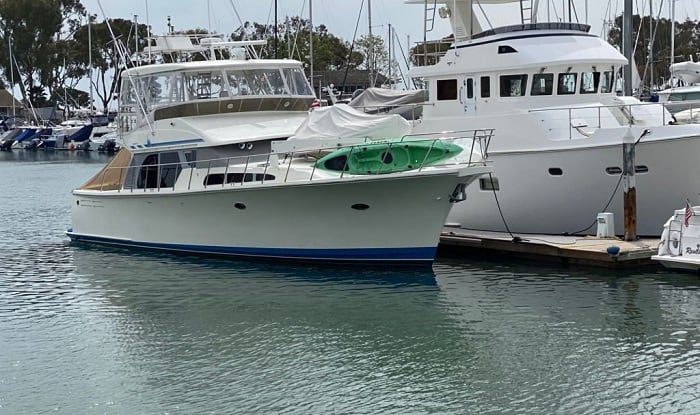
Most shipwrights and boat owners will measure the length of a boat using something as simple as a tape measure. Of course, you’ll need to be specific about the exact length parameter you’re trying to pinpoint.
Are you trying to measure the overall length or the waterline length? Follow these guidelines to learn how are boat length measured:
Normally, the LOA includes all the protrusions. You can start from the bow’s tip and end at the stern’s furthest point. Keep the tape straight and taut while taking the measurement!
At best, how we measure it readily reveals the exact length overall definition. Basically, it’s the vessel’s “true length,” as it includes everything attached to it.
Measure only the length of the deck minus protrusions.
Measure from bow to stern as well, but keep only the submerged portion of the hull in mind. You can usually rely on the grime build-up from the dirty water to measure the waterline length.
However, if there is no impurity mark on the boat, you’ll have to use a pen to mark every 1 foot or so on the vessel when it’s docked. Once it’s back on land, you can use a tape measure to size it.
Incidentally, do you know what unit would be best for measuring a boat’s length? Well, if you look at standard boat listings, they often tell the vessel’s size outright using feet.
It’s really a matter of feet being a simpler unit of measurement than most, plus the fact that it has been an ongoing tradition set by the British.
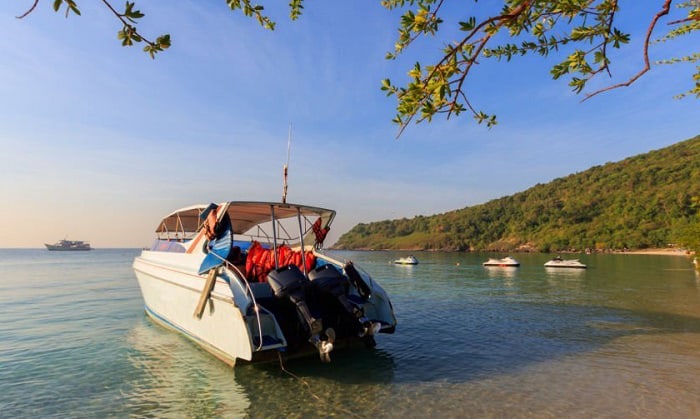
Overall, length plays more of a central role because of the following facts:
- There’s no better way to be familiar with average boat size and the exact size of your own vessel than taking these measurements. You’ll be able to figure out its legal size and know the exact safety and operation regulations you need to be mindful of before going out to sea or lake.
- You’ll have a good idea of its exact capacity in terms of payload, passengers, and cargo.
- You’ll be able to know its strengths and weaknesses performance-wise more intimately. Waterline measurements have been the standard gauge for determining racing performance, for example.
- You’ll be able to know the exact storage requirements for your boat.
- Overall, in order to operate and sell it legally, you need to know a vessel’s exact dimensions.
- Insurance companies need to determine how large or small your vessel is to know its exact premium.
- You need to know how many crew you need to bring along at the minimum.
- Taking the exact boat height measurement as well as length and width allows builders and owners to make the necessary improvements. For example, did you know that small fishing boats in Japan have had their hulls measured to make them more efficient?
- How will you be able to know the exact cover for your boat if you don’t know how long it is? Boat covers need to be a snug fit, but not overly so, to avoid potential problems.
What about swim platforms?
If you’re trying to measure the exact length overall of your vessel, you need to include accessories like swim platforms in your boat measurements.
However, if you’re only trying to find out something specific such as length on deck or taking waterline measurements, you can leave them out.
As I’ve said above, feel free to use a tape measure you have on hand. You can also use telemeters, assuming you’ve got them, to measure a boat length.
Most owners who measure both their boat and its trailer rely on a tape measure, protractors, and a trailer measurement form for noting down the dimensions, usually handed out by the trailer manufacturer.
I hope that by finding out exactly how are boats measured, you’ve come to the same conclusion that it’s a fairly straightforward process. The facts above also outline and underline the reasons why people measure these vessels.
Thankfully, it’s not as complicated as, say, measuring boat chemistry. All I’m going to say is that you shouldn’t overlook these dimensions, especially if you want to get the most out of your boat, not only when you’re operating it but presenting it to potential buyers.
Read more : Tips to measure a boat steering cable.

“My intention from the first day establishing Boating Basics Online is to provide as much help as possible for boaters who want to experience a first safe and convenient trip. So feel free to join us and share your beautiful journeys to the sea!”
Get your card today

- Pre-paid code

- Buy a Gift Card
Boat Sizes: Chart, Classifications and Length
To operate a boat safely and legally, you need to have the right type of safety equipment on board at all times. But how can you know what type of equipment is required for your specific type of boat?
The key is discovering your boat’s class .
And boat classes are determined by boat length .
Let’s take a look at the four different classes of recreational boats, so that you can be prepared when you take to the water.
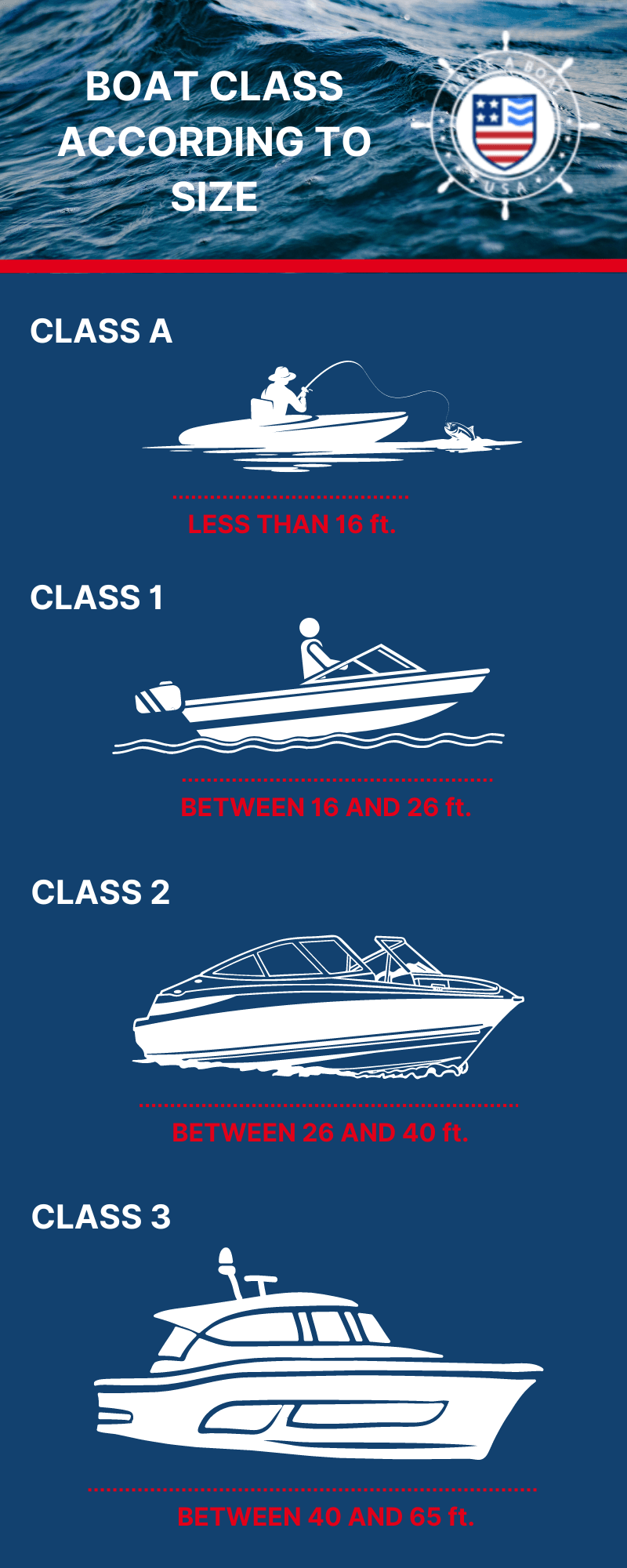
How to measure your boat
You can measure your boat along its centre line from bow to stern, not including any extra attachments like swim platforms. Check out our page outlining the parts of a boat to help you make an accurate measurement.
Class A: Boats measuring less than 16 feet
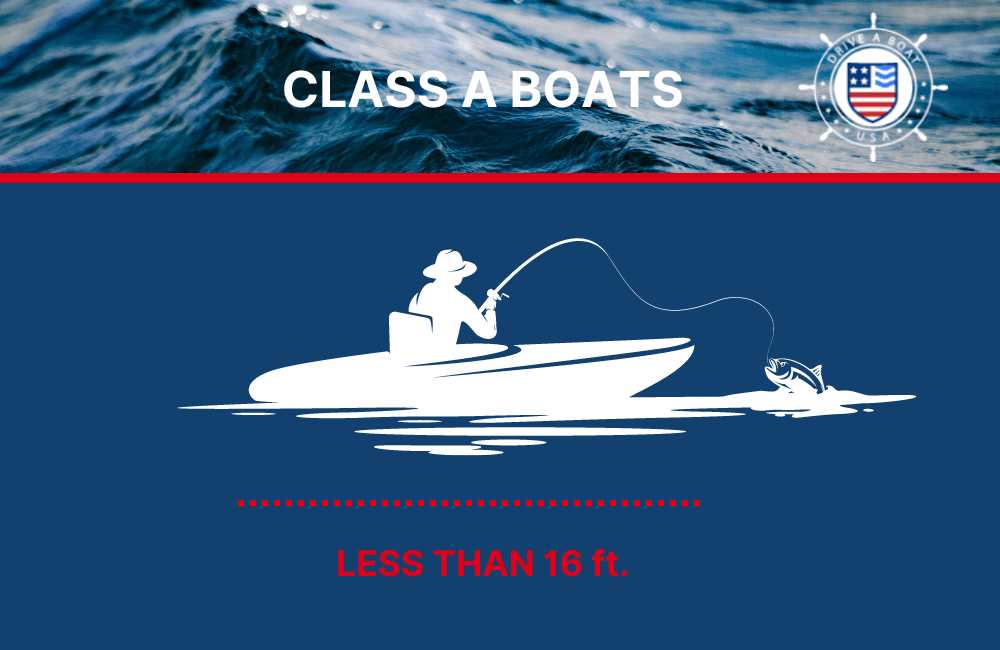
This class includes small fishing boats, canoes, dinghies, personal watercraft and rowboats. To operate this class of boat safely, you need to have:
- Personal flotation devices (PFD) for each person on board or being towed on water skis, etc.
- A bell or whistle
- Visual distress signals (for certain bodies of water) for night-time use
- A fire extinguisher (depending on several factors)
- Ventilation
- A back-fire flame arrestor
Class 1: Boats measuring between 16 and 26 feet

This class includes pontoon boats, jet boats, aluminum fishing boats, smaller deck boats and ski boats. To operate this class of boat safely, you need to have:
- One approved Type I, II or III personal flotation device (PFD) for each person on board or being towed on water skis, etc. and one throwable Type IV device
- Visual distress signals for day and night-time use
Class 2: Boats measuring between 26 and 40 feet
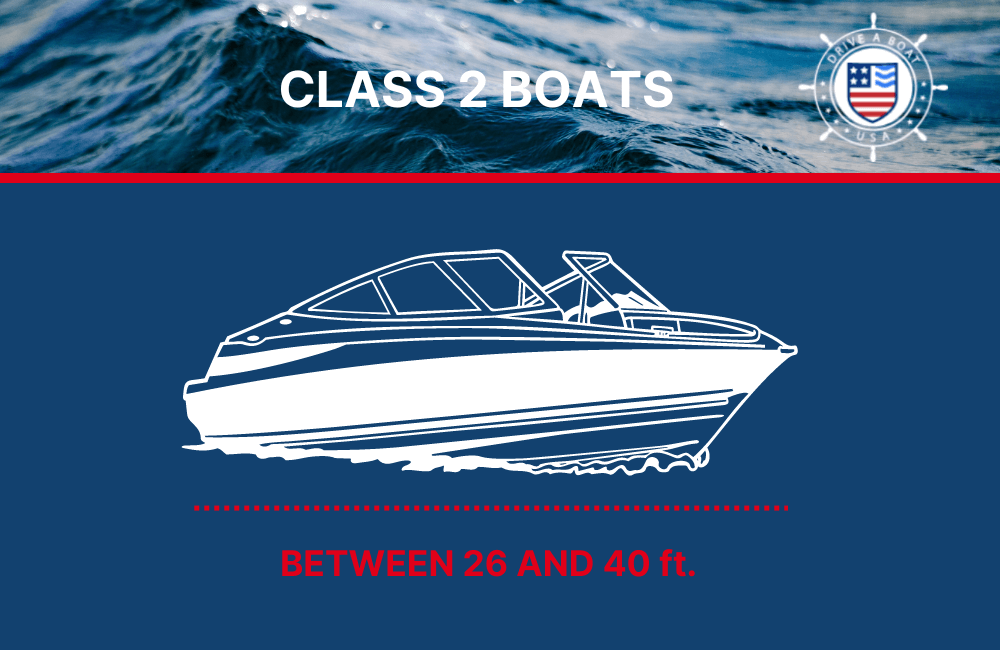
This class includes cabin cruisers, trawlers, sail boats, bowriders and runabouts. To operate this class of boat safely, you need to have:
- A bell or whistle that is audible for 1 nautical mile
- 2 fire extinguishers
Class 3: Boats measuring between 40 and 65 feet
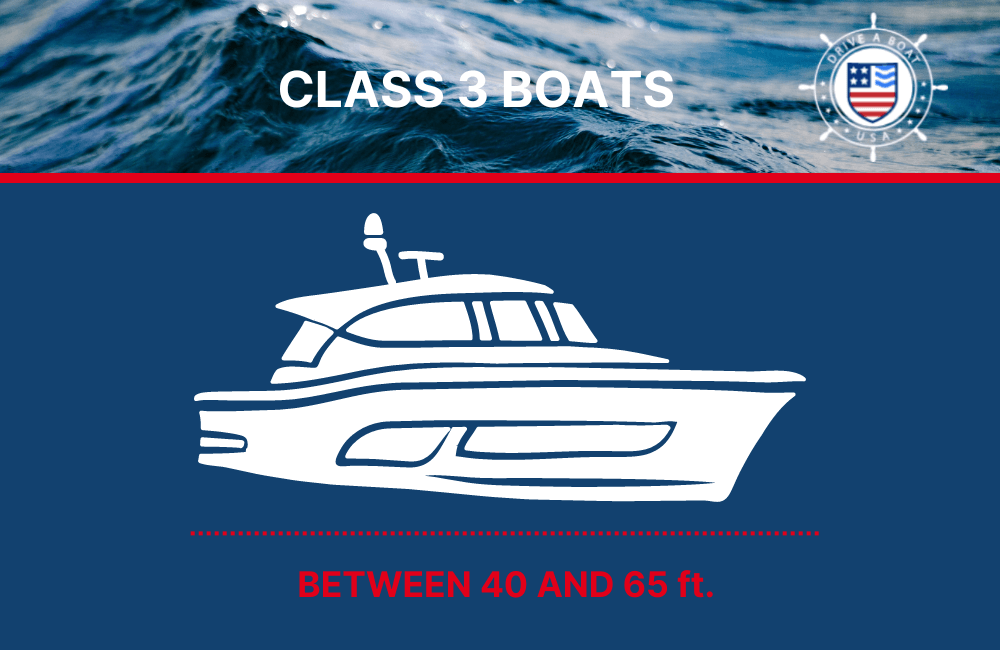
This class includes yachts, sport fishers, catamarans, sail boats and go-fast boats. To operate this class of boat safely, you need to have:
- 3 fire extinguishers
Remember that there could be some variations in the specific type of equipment you need, even within these categories. The best way to be certain that you are prepared to go out on the water is to get your official online state approved boating license .
Learn how to equip your boat with Drive a Boat USA
Whether your boat falls into Class A, 1, 2, or 3, you are responsible for keeping the right safety equipment on board at all times.
Learn what you need to know to enjoy safe and successful boating adventures, including how to drive a boat , from Drive A Boat USA.
Contact us today to earn your official state-approved boating license and take to the water!
- USA Boating
Latest Posts
- Downstream vs Upstream in a Boat: What’s the Difference?
- Boat Propeller Strike: Avoiding Injuries and Accidents
- Starboard Side and Port Side Explained
- Water Skiing Hand Signals
- Water Skiing & Towed Water Sports Safety Guidelines
- February 2024
- December 2023
- October 2023
- September 2023
- January 2023
- November 2022
- Get certified now
- Replacement California Boater Card
When is a Boat a Yacht?
Types of yachts – sizes, styles, & categories.
With so many different types of yachts to choose from, it can be hard to know your Flybridges from your Tri-Decks if you’re just starting your search. Although there is a growing number of terms used to describe the different types of yachts out there, many of the terms overlap or are used interchangeably.
If you’re on the market for a yacht, the team here at Van Isle Marina has compiled a review of the different terms you’ll likely come across when cruising through yachts for sale .

a luxury motoryacht
Below is our brief guide to understanding the different terms the boating community has been known to use to describe yachts.
Definition of a Yacht
What exactly makes a yacht a yacht, and not just a big boat? There is no nailed down definition of what makes a yacht a yacht, but most boaters consider a yacht to be any type of sea vessel that is used strictly for recreational or pleasure purposes like cruising , entertaining, water sports, fishing , or year-round accommodations.
Yachts are usually large enough to have some form of sleeping quarters (cabin) on board for overnight trips as well as a kitchen (galley) and a bathroom (head). They are also large enough that they require more than human inputs (i.e rowing) to propel forward.
Yachts are classed by many things, including their mode of propulsion, size, style, amenities, and function.
General Types of Yachts

a sailing yacht
A yacht is first defined either as a sailing yacht, motor yacht, or gulet yacht, and then as a sports or luxury yacht.
- Sailing Yacht: a yacht mainly propelled via wind and sails
- Motor Yacht: a yacht propelled via one or more motors
- Gulet Yacht: a hybrid yacht with both sails and motors
- Open Yacht, Cruiser, Cabin Cruiser, Express Cruiser: an otherwise uncategorized standard yacht for cruising and entertaining
- Luxury Yacht: a yacht that includes high-end finishes and features and the latest in modern performance technology. The term ‘luxury’ can precede any type of yacht, i.e. “luxury motor yacht”, “luxury sailing yacht”, etc.
- Sports Yacht: a yacht geared towards fishing, water sports, or cruising with a sleeker design and more powerful motor for faster cruising speeds. The term ‘sports’ can precede other types of yachts as well, i.e. “sports motor yacht”.

a catamaran
Yacht Sizes
Yachts can further be defined as a superyacht or megayacht, depending on their size.
- Super Yachts are typically 24 meters (78 feet) and above.
- Mega Yachts are typically over 80 meters (260 feet).
Most motor yachts on the market are typically 24 meters (78 feet) or less. There are only a handful of megayachts in the world due to their extravagant price tag.
Yacht Style Categories
Yachts can further be grouped or defined according to their form and function, such as with flybridge, sedan, pilot house, and sportfish yachts, for example.
- Classic Motor Yacht: a yacht that was built between the 1920s and 1970s (before today’s modern technology began dominating modern yacht manufacturing). A modern yacht can be built based on the classic motor yacht style.
- Sedan: a popular yacht style with deck space above the hull and living quarters below. The living quarters of a sedan yacht are enclosed and single-level.
- Flybridge: a sedan-style yacht with an open deck and more comfortable living space above the main bridge of a vessel.
- Daybridge: a multi-level yacht that is even more open than a flybridge. Belize Motoryachts are known for creating this distinctive style of yacht.
- Open or Enclosed: a term used to describe the layout of and access to the flybridge. In an enclosed flybridge, access to the above flybridge is enclosed inside the living space. In an open flybridge, access to the flybridge above is open to the elements.
- Downeast Style: a low-profile yacht with a large working cockpit and small helm station. This highly recognizable style is inspired by the mid-1900s traditional Maine lobster boat. Back Cove yachts are a shining example of downeast-style inspired yachts.
- Pilothouse: A multi-deck yacht like a flybridge with a larger interior main deck.
- Sky Lounge: an enclosed area at the top of the vessel that provides the benefits of the view but with several amenities, protection from the elements, expansive windows and sometimes a sunroof.
- Cockpit Motor Yacht: a yacht with more cockpit space than deck space.
- Sportfish or Sport Fishing Yacht: A yacht used for fishing with a large cockpit, storage space, and the ability to handle rougher seas. These can also be referred to as Flybridge Sportfish or Sportfish Express and are built for longer durations out on the water.
- Convertible: a yacht that combines features of a standard motor yacht with a sportfish yacht to have entertaining space when you need it, and also fishing space when you need it.
- SUV: a yacht that combines features of a standard motor yacht and sport yacht.
- Tri-Decks : a superyacht with three levels of staggered, enclosed living space.
- Expedition Yachts: a large yacht with a deeper displacement hull for more stability and comfort during longer-range trips.
Read a few descriptions of yachts for sale and you’ll soon realize the boating community sometimes seems to have its own language. To accompany this roundup of yacht types, check out our Parts of a Boat post for more information, or jump right into checking out some of the models we at Van Isle Marina have for sale right now.
250 656 1138
2320 Harbour Road, Sidney, British Columbia V8L 2P6 [email protected]
Marina Services
Marina Layout
Yacht Sales
- Share on Facebook
- Link to Instagram
©2024 Van Isle Marina | Design by Caorda
Yachts are a category of boats and ships that are primarily used for leisure activities. They range in size from small, cabin-equipped boats to large, luxurious vessels complete with crew quarters, multiple decks, and opulent amenities. Unlike other types of boats, yachts are often associated with comfort and luxury, offering a high level of accommodation and equipment. They can be motor-powered or sail-driven and are designed for cruising and longer voyages, providing everything needed for extended stays on the water. Yachts are popular for private excursions, social events, and competitive sailing, reflecting a lifestyle of recreation and exclusivity on the seas.
Yachts began as vessels used by the Dutch Navy to chase pirates and privateers. The term "yacht" comes from the Dutch word "jacht," meaning "hunt." The concept shifted when the wealthy started using these boats for pleasure cruising. By the 20th century, yachts had become a symbol of luxury and opulence, with larger and more extravagant designs. Sailing yachts gained popularity for sport and recreation, while motor yachts became the choice for those seeking comfort and travel over longer distances. This led to a rise in custom-built yachts, designed to cater to the specific desires of their affluent owners.
Yachts are set to become even more sophisticated with advancements in technology and sustainability. Expect to see solar panels and hybrid engines for cleaner cruising, and cutting-edge navigation systems for easier handling. Yacht designs may prioritize eco-friendly materials and self-sustaining features like water purification systems. Innovations like the Oceanco NXT reflect the industry's move towards sustainability without compromising luxury. As society becomes more environmentally conscious, yachts will likely serve as a testament to the possibility of luxurious yet responsible travel. They will continue to be emblems of status and comfort, but with an increasing emphasis on harmony with the marine ecosystem.
Yachts are classified by size into several categories: Day sailing yachts are usually under 20 feet (6 meters); Weekender yachts span 20 to 30 feet (6 to 9 meters); Cruising yachts range from 30 to 50 feet (9 to 15 meters); Luxury yachts are typically 50 to 100 feet (15 to 30 meters); Superyachts extend from 100 to 200 feet (30 to 60 meters), and Megayachts exceed 200 feet (60 meters). These classifications reflect the yacht's size-related amenities and operational needs.
A yacht crew structure includes the captain, who oversees all operations; deckhands for maintenance and handling lines; engineers for engine and systems maintenance; a chef for meal preparation; and stewards or stewardesses for interior service and guest care. Larger yachts may also have first mates, navigators, additional engineers, specialist chefs, and a purser to manage finances and provisioning. Crew size increases with the yacht's size and complexity.
The most prestigious yacht-building companies include Lürssen and Blohm+Voss, renowned for their custom-built superyachts; Feadship and Amels, known for craftsmanship and innovation; Azimut-Benetti and Ferretti Group, celebrated for Italian design and luxury; Sunseeker, which offers high performance and bespoke finishes; and Heesen, respected for their high-quality Dutch engineering. These companies have established reputations for excellence in the yachting world.
Wikipedia - Yacht Wikipedia - Superyacht
* Under Development *

Do you know your numbers when it comes to sizing up your boat? Accurate measurements for figures like length, draft, beam and clearance will keep your boat free from damage in marinas and private boat dock slips as well as while traveling beneath fixed bridges.
Boat length is measured from the bow to the stern. However, the number is not as set in stone as it may seem. It can vary depending on whether there’s a swim platform, a bow pulpit, a dinghy on a davit or other things that contribute to the length overall (LOA). Knowing the correct length of your boat is just as important as knowing how to properly operate it. We’re not talking about that number the manufacturer says it is … the one that’s part of the model name. For example, a Hatteras GT45X is 45 feet long, but with a swim platform and a bow pulpit, it could technically come closer to a total of 47.5 feet. This number can change from boat to boat (even among the same model and manufacturer) as well as type of boat. Correct length is especially useful when docking or choosing a private boat dock rental. Trying to fit a boat into a slip that’s too small can result in damage to the boat, the dock and other property around it.
Example Average Length
- Cruising Sailboat: 16’ – 50’
- Catamaran: 32’ – 47’
- Cabin Cruiser: 25’ – 45’
- Motor Yacht: 29’- 65’
- Center Console: 18’ – 32’
Another important factor is draft. A boat’s draft refers to the vertical distance from the waterline (where the hull touches the water) to the bottom of the hull, or keel on a sailboat. It determines the minimum depth of water a boat can safely navigate without running ashore (which, by the way, is very bad). Put simply, it helps you know how deep the water needs to be. Like length, it can vary from boat to boat. A sailboat can have a very large draft based on whether it has a keel (and whether the keel is removable). Each dock has its own specific draft allowance, which is based on things like water level, tides and how flat or angled the ground is under the water. One dock can be vastly different than others in the area. Dock draft measurements can be taken by dropping a long length of rope (weighted) or chain into the water, marking it at the water level and then measuring from the bottom up out of the water. Private docks on our site are listed at the low tide water level. This way, you know the absolute minimum depth of water. It’s always best to be conservative by one or two feet if you’re not completely sure you’ll be able to dock at that boat slip – due to things like changing tides, weather and boat wakes.
Boat Size vs Draft
- Low Draft: A boat 32 feet long and under needs 3 feet or less of water
- Medium Draft: A boat 45 to 65 feet long needs 4 to 5 feet of water
- High Draft: A boat 65 feet long or greater needs 5 to 7.5 feet of water
To throw a wrench into these statistics, there are instances where this might vary. Sailboats can be an exception as they may have a non-retractable keel, which gives them the need for a larger draft (since the keep gives them a bigger draft measurement). On the other hand, since catamarans are wide and displace water very efficiently, they may only need 4.5 feet of draft even if it falls into a bigger category.
Average Boat Draft
- Cruising Sailboat: 5’ (but could be more if it has a non-retractable keel)
- Catamaran: 2’ – 4’(large cats could need more)
- Cabin Cruiser: 3’
- Motor Yacht: 4’ (the bigger the yacht, the bigger the draft)
- Center Console: 2’
As a general rule, the bigger the boat is, the deeper the draft will need to be. Factors like weight and beam play into this concept. The hull shape can also play a part. A flat or multi-hull boat (like pontoon boats, jet skis and dinghies) has a low draft. A deep V-shaped displacement hull (like most power boats and cruisers) allows the boat to sit deeper in the water, resulting in a high draft.
Beam refers to the distance from the widest point of the boat to the other side (think: middle of the boat from side to side). Catamarans are very wide compared to that of center consoles and cabin cruisers. Most boats fall into the 18 to 20-foot beam category, but cats can be as wide as 22 to 30 feet.
The beam of a boat will determine how wide of a boat slip rental you need. You’ll want to measure the dock to make sure it’s wide enough that your boat won’t bang against the sides.
Average Beam
- Cruising Sailboat: 12’
- Catamaran: 22’ to 30’
- Cabin Cruiser: 8.5’
- Motor Yacht: 13’
- Center Console: 9’
Clearance, or vertical clearance, is important for sailboats and catamarans with a fixed mast, as well as sportfish boats with tall towers. It refers to the height of the boat from the waterline to the top of the mast or flybridge (or any non-removable part). Some masts can be lowered, so that would not be included in your clearance number.
Out in the wide-open ocean, clearance isn’t too much of an issue. The time it becomes an issue is when you’re sailing under a fixed bridge. A drawbridge is no problem. You just need the patience to wait till it opens. Sailboats can require anywhere from 35 to 75 feet of vertical clearance, so you’ll want to check out those fixed bridge heights when charting your course or choosing a boat dock for rent. Be sure to take into account low tide when determining clearance.
Average Boat Clearance
- Cruising Sailboat: 50’
- Catamaran: 39’
- Express Cabin Cruiser: 9’ 10 “ with tower up / 7’ 7” with tower down
- Motor Yacht: 14’ to 15’
- Center Console: 9’ 6”
Whether you’re docking your boat at a marina, a mooring or a private boat dock rental, the correct measurements play a big factor. Hopefully this has given you some good advice to make the whole docking process a bit easier. Now if you could just control the wind while docking.

Yachting Monthly
- Digital edition

How much anchor chain?
- Katy Stickland
- August 26, 2019
When it comes to putting out anchor chain, most of us follow a basic ratio rule of thumb, but we should be taking wind and tide into account, argues Christopher Smith

A busy anchorage clearly requires you to reduce your swinging circle by using less chain than you might otherwise use, but how do you know you won't drag?
Anchoring is a key part of the cruising sailor’s arsenal – at least for those who don’t intend to take refuge in a marina every time they wish to stop sailing.
For such a vital aspect of our pastime, however, it can be difficult to get solid information on many aspects of the process.
This is due, in no small part, to the complexities in working out issues such as chain length.
What is needed in most circumstances is a handy rule of thumb, which can be used to ensure you are anchoring safely in most circumstances.
By its very nature, a rule of thumb calculation cannot take into account all aspects of the anchoring equation, but it is surprising how many miss out quite vital considerations simply because they can be hard to make fit a certain simplified formula.
Everyone has their own idea of how much anchor chain to use. The simplest – and perhaps most often used method – why leave all of that chain you have stored in the locker?
In reality this usually means using the maximum safe length – any anchorage has rocks, shallows and other boats at anchor either when you arrive or, often, turning up after your arrival.
So how do you decide what is safe before looking elsewhere to anchor? Traditionally you use the scope – a multiple of the water depth to determine the length of anchor chain you’ll need to use. The RYA suggest a scope of at least 4:1, others say you need 7:1 but in crowded anchorages 3:1 is quite common.
A moment’s thought, however, tells you that a static rule of thumb in an environment that can significantly change in different conditions will not sufficiently account for the main forces acting on your boat, namely the wind and the tidal stream.
Often, wind is going to be the biggest concern, so you must take this into consideration and also be aware of, and prepared for, the maximum anticipated wind strength. And there’s the problem; there are virtually no articles or text books on anchoring to tell you how to take into account the wind strength when setting your anchor.
So I’ve come up with a very simple guide to provide a rule of thumb calculation (above), which also takes wind and tide into account.
If you will not see anything greater than the top end of Force 4 (16 knots) and you are anchoring a 10m yacht in fairly shallow water, by which I mean anything under about 8m depth, you should be fine with 16m + 10m = 26m of chain. But if you think a Force 7 gale (33 knots) is coming, try setting 33m + 10m = 43m of chain. This rule of thumb works in the majority of anchorages relatively close to the shore where the water is quite shallow, but for deeper anchorages (of around 10-15m) you obviously need more chain.
The answer to this is simple: you just need to use a factor of 1.5 times the wind speed, which will deliver a better result.
Wind-ONLY formula for shallow anchorages (4 to 8m) Chain needed (m) = wind speed (knots) + boat length (m)
Calculating length: a rule of thumb.
- Simple equation The most basic equation is: wind speed + boat length = chain length. This works for anchorages up to around 10m. Beyond that depth, calculate 1.5 times wind speed instead.
- Calculating tide Tide can also be taken into consideration, by converting the tidal force asserted to your boat into a relative wind speed. Motoring into varying headwinds and noting the engine rpm and then seeing what boat speed the same revs provide in calm conditions can provide a surprisingly accurate wind speed to tidal flow conversion.
- Adding some more It is wise to add roughly one additional boat length to our calculations to ensure there is enough slack to counter the yawing at anchor without a direct upward pull on the anchor.
- Plan ahead Make sure you consider not just the conditions of the anchorage as you arrive but what they might become. Is the wind forecast to increase significantly? Is there a likelihood of the anchorage becoming significantly busier while you are there? How much tidal stream do you expect to flow through the anchorage when the tide changes?
Different types of anchor pros and cons

Traditional fisherman anchors can be folded flat for easy strowage and hold well on rock and weed, but tiny flukes are likely to drag on any other bottom, ruling it out as a main anchor.

CQR, Delta and Kobra II anchors may drag if pulled hard enough, tilling the seabed if it is soft sand or mud. Designes have evolved to increase their maximum holding power.

The genuine Bruce has not been made for very many years and many copies have been produced, often in low-grade, brittle and weak materials. The genuine item sets and holds well in soft-to-medium bottoms, is said to hold on rock, but its long leading edge struggles to cut through weed.
Flat anchors

Danforth, Britany, FOB, Fortress and Guardian anchors have a large surface area for their weight, and hold well in soft-to-medium bottoms. On hard bottoms, such as packed sand and shingle, they can skid without setting and they tend not to reset when the tide or wind changes the direction of pull.
New generation

This category includes the Bügel, Manson Supreme, Rocna, Sarca and Spade. Their designs aim to make them easier to set and reset if the tide changes, with increased holding power.
Catenary Curves
The starting point for these calculations is the curvature of the chain in the water, the catenary, which transfers the lateral force from boat to seabed. The maths isn’t fun, but for typical anchoring conditions, the catenary length turns out to be closely linear with wind speed, but with a slope that increases only as the square root of the anchoring depth.
For shallow anchoring (5-8m) the slope is close to unity: catenary length (m) = wind speed (knots). With deeper anchorages(15m) the slope rises to 1.5 and onwards to 2 at 20m depths.
The square root factor with depth makes clear that the concept of scope is flawed. For example, anchoring in 4m of water with a Force 5 wind either present or expected, you need 32m chain, a scope of almost 8:1.

The amount of anchor chain that you use in calm conditions should be different to that needed when the wind is up
As Rod Heikell says ( Yachting Monthly , Summer 2018) ‘Forget the 3:1 scope usually touted: go for at least 5:1, and if you have swinging room, more.’
What I say is forget the concept of scope entirely!
The force of the wind also depends on the shape (windage) of the boat. You can measure this for your own boat by measuring the amount of chain lifted at a given wind speed (V) and depth (D) with the formula: catenary = f.V.√D .
My ‘shallow anchorages’ calculation is based on my boat (10.4 m Jeanneau Espace, 10mm chain) and a depth of 6m. Values will be reasonably similar for most production yachts, assuming the chain size increases according to the boat size.
Chain on the seabed
We can calculate the length of the catenary – but is this the right amount of anchor chain to use?

Christopher Smith has had a series of shared ownerships in Greece.
Years of swimming down to watch the anchor in warm Mediterranean waters has convinced me that an optimal chain length is the catenary plus a boat length.
This gives a buffer to counter the yawing at anchor without a direct upward pull on the anchor.
Also a length of chain bedded in the sand or mud substantially reduces the pull on the anchor. So my best guess is: total chain = catenary + boat length.
Some people say that in order to drive the anchor into the seabed the chain needs to be angled upwards, i.e. a length slightly less than the catenary. However this is exactly why we use the motor in reverse after anchoring – to lift the chain angle and drive the anchor down.
No consideration is given here to the holding power of the anchor. That’s essential and is discussed in many other articles.
Tidal streams
The second force acting on your boat is the drag of tidal streams. Surprisingly you can easily measure this yourself.
On a windy day motor slowly into the wind, reduce revs, and find the engine revs that just balances the wind force. Then on a calm day note the boat speed produced by the same revs.
With my boat, a full Force 4 wind needed 1200 rpm to balance the wind force – and when calm 1200 rpm gave 4.2 knots speed over ground. Thus a 4.2 knot tidal current would correspond to a 16 knot wind force, which needs 16m chain to balance it, i.e. about 4m of chain per knot of current.
So we now have a more complete formula.
Anchor chains are usually marked in 10m stages, so a practical approach is to round the calculations to the nearest 10m of chain.
With 10m boat length added, this gives an easy to use table (below).

It seems extraordinary that for all the articles on anchoring and discussions on scope there is so little consideration of how to allow for wind strength.
Yes, there are geek articles on catenary lengths, but little attempt to apply this into sailing practice. I hope here to at least reawaken your thought processes of how to choose an appropriate length of anchor chain.
It’s actually not so hard after all.
Wind & tide formula for shallow anchorages (4 to 8m) Chain needed (m) = wind speed (knots) + 4 x water speed + boat length (m)
Enjoyed reading this?
A subscription to Yachting Monthly magazine costs around 40% less than the cover price .
Print and digital editions are available through Magazines Direct – where you can also find the latest deals .
YM is packed with information to help you get the most from your time on the water.
- Take your seamanship to the next level with tips, advice and skills from our experts
- Impartial in-depth reviews of the latest yachts and equipment
- Cruising guides to help you reach those dream destinations
Follow us on Facebook , Twitter and Instagram.

IMAGES
VIDEO
COMMENTS
A yacht would be considered a large yacht once it's length is over 79 feet. A yacht is considered a superyacht or megayacht if it is over 115 feet long. The yacht the holds the record for being the longest yacht is 590 feet long. This yacht is called the "Azzam" and has held onto its title for over 5 years.
List of motor yachts by length. M/Y Azzam, seen here in Cadiz, Spain, during the summer of 2020, is the world's longest luxury yacht. This list of motor yachts by length, is a table of the world's longest active superyachts, with an overall length of at least 75 metres (246 ft) and up. These boats are also known as "megayachts", "gigayachts ...
Yachts can vary greatly in size. The average size of a yacht ranges from 30 to 60 feet. However, larger yachts, known as superyachts, can measure over 100 feet in length. FAQ 5: What is the advantage of a catamaran or trimaran? Catamarans and trimarans provide more stability due to their dual or triple hull design.
A yacht of 60 meters length will have a crew of 20-23 members. A yacht of 80 meters length can have a crew of up to 80 members. The maximum number of guests will depend on yacht registration type. Many owners choose to keep maximum of 12 guests, since it allows for a simpler regulation regime.
A yacht ( / jɒt /) is a sailing or power vessel used for pleasure, cruising, or racing. [2] [3] [4] There is no standard definition, though the term generally applies to vessels with a cabin intended for overnight use. To be termed a yacht, as opposed to a boat, such a pleasure vessel is likely to be at least 33 feet (10 m) in length and may ...
Yachts are typically measured in feet and/or meters. The measurement is typically taken from the tip of the bow to the stern of the craft. Some yachts may also be measured in gross tonnage which is a measure of their volume and carrying capacity. Gross tonnage is calculated by multiplying the length of the yacht by its maximum width, then by ...
Beyond a length of 130 feet, the vessel is typically called a "super yacht" (sometimes written as one word, superyacht). Sidebar: the current reigning champion for the longest yacht in the world is the super yacht Azzam, which is 590 feet in length.
When it comes to the size of a yacht, there are a number of factors that can influence the overall length of the vessel. Generally speaking, yachts come in a wide range of sizes, with the average length being around 40 80 feet. Smaller yachts, such as day-sailers, typically range in length from 25 45 feet.
The latest power yacht launched in September 2019 is a whopping 182 meters, while the biggest sailing yacht rings in at a fraction of the length at 102 meters. However, that 182-meter power yacht can float in only 4 or 5 meters of water. The sailing yacht, on the other hand, requires at least 10 meters to avoid bouncing her lead keel along the ...
In walking the docks, comparison of side by side vessels of equal length immediately identifies the variables of beam and height. Yachts between 40 meters and 50 meters could feasibly have equivalent internal volume dependent on beam and the number of decks. Length in and of itself can be a deceptive figure.
Large yacht. A large yacht is a pleasure vessel with a load line length equal to or over 24m. Almost all the flag administrations have adopted safety codes dedicated to large yachts and this is, therefore, the only definition having a universal meaning in the international regulatory framework of yachts. Commercial yacht
Large Yachts. 70 to 100 feet. Super Yachts. 100 to 200 feet. Mega Yachts. Over 200 feet. To determine a yacht's size, start by measuring from the front to the back end, which gives you the overall length. Remember, this measurement, known as length overall (LOA), includes everything from the main deck to any forward-pointing parts or rear ...
The class of a yacht isn't just about its length; it encompasses several factors that contribute to the overall experience. These factors include the yacht's size, style, facilities, crew requirements, and intended use. Yacht classes can range from sleek, racetrack-ready vessels to floating palaces designed for opulence and comfort. ...
A Generic 34 may be 32ft long, for example, and a White Boat 37 could be 39ft. The North Sea 24 (an ancestor of the Rustler 36) is actually 31ft long - 24ft was her waterline length which used to be the minimum required by RORC. Some builders overstate their boats' lengths in model numbers to make the price tag look like better value, while ...
Common Motor Yacht Sizes: 40-49 Feet >>> Perfect size yacht for couples and small families. Motor Yachts in the 40-50 foot range make great starter yachts and can be owner operated. In this range, motor yachts will typically highlight 1-3 staterooms, sleeping anywhere from 2-6 people. 50-59 Feet >>> Motor yachts 50-60 feet are great for larger ...
Length - This unit often takes the spotlight because it includes critical elements such as length overall, length on deck, and waterline length. It's also what helps to determine boat classifications. Width - To measure the width of a boat is to know its beam, which is its upper surface's widest extent. The average width of a boat is 8 fee.
Class 3: Boats measuring between 40 and 65 feet. This class includes yachts, sport fishers, catamarans, sail boats and go-fast boats. To operate this class of boat safely, you need to have: One approved Type I, II or III personal flotation device (PFD) for each person on board or being towed on water skis, etc. and one throwable Type IV device.
Yacht Sizes. Yachts can further be defined as a superyacht or megayacht, depending on their size. Super Yachts are typically 24 meters (78 feet) and above.; Mega Yachts are typically over 80 meters (260 feet).; Most motor yachts on the market are typically 24 meters (78 feet) or less.
Yachts are classified by size into several categories: Day sailing yachts are usually under 20 feet (6 meters); Weekender yachts span 20 to 30 feet (6 to 9 meters); Cruising yachts range from 30 to 50 feet (9 to 15 meters); Luxury yachts are typically 50 to 100 feet (15 to 30 meters); Superyachts extend from 100 to 200 feet (30 to 60 meters ...
The answer is, it depends. When I started writing about boats over two decades ago, the Mason-Dixon line stood firmly at 80 feet. That was the length overall where we stopped calling a model a "boat" and switched to the term "yacht.". Editors, at the time, reasoned that once a boat owner hit 80 feet length overall, hiring a crew was no ...
Low Draft: A boat 32 feet long and under needs 3 feet or less of water. Medium Draft: A boat 45 to 65 feet long needs 4 to 5 feet of water. High Draft: A boat 65 feet long or greater needs 5 to 7.5 feet of water. To throw a wrench into these statistics, there are instances where this might vary.
Length overall (LOA, o/a, o.a. or oa) is the maximum length of a vessel's hull measured parallel to the waterline. This length is important while docking the ship. It is the most commonly used way of expressing the size of a ship, and is also used for calculating the cost of a marina berth (for example, £2.50 per metre LOA).
Simple equation The most basic equation is: wind speed + boat length = chain length. This works for anchorages up to around 10m. Beyond that depth, calculate 1.5 times wind speed instead. Calculating tide Tide can also be taken into consideration, by converting the tidal force asserted to your boat into a relative wind speed.
Length: 239ft. Google co-founder Sergey Brin. Photo: @thebiographypen/Instagram ... "The yacht is to be home away from my home in Seattle, and its style should match the style of the house ...